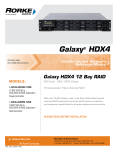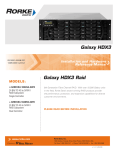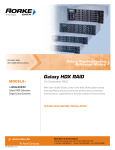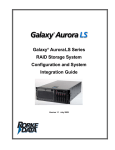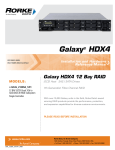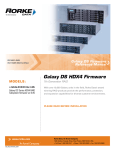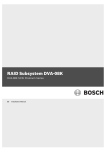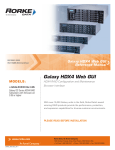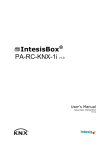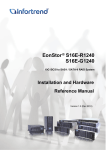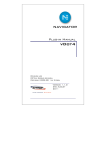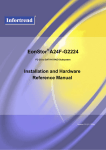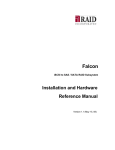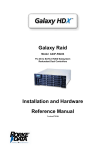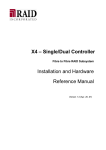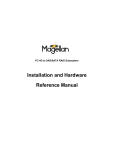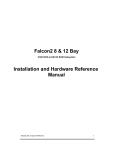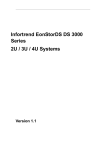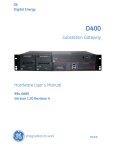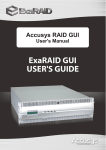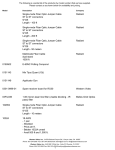Download 16-bay Single/Dual Ctrl
Transcript
Galaxy® HDX4 ISO 9001:2008 ISO 13485:2003 Certified MODELS: Installation and Hardware Reference Manual Galaxy HDX4 16 Bay RAID Fibre Channel and iSCSI Host SAS / SATA Drives 16 BAY FC-8G & iSCSI to SAS/SATA II RAID Subsystem Single Controller 7th Generation Fibre Channel RAID 16 BAY FC-8G &iSCSI to SAS/SATA II RAID Subsystem Dual Controller With over 10,000 Galaxy units in the field, Rorke Data’s award winning RAID products provide the performance, protection, and expansion capabilities for diverse customer environments. PLEASE READ BEFORE INSTALLATION www.rorke.com GX4L_2842_16F8i!0211_HMN Rorke Data, An Avnet Company 7626 Golden Triangle Drive, Eden Prairie, MN 55344, USA » Toll Free 1.800.328.8147 » Phone 1.952.829.0300 » Fax 1.952.829.0988 Table of Content Table of Content ............................................................................................ 1 Contact Information ................................................................................................... 4 Copyright 2010 .............................................................................................. 5 This Edition First Published 2010 .............................................................................. 5 Disclaimer .................................................................................................................. 5 Trademarks ............................................................................................................... 5 Warnings and Certifications ...................................................................................... 6 FCC Class A Radio Frequency Interference Statement ........................................... 6 Safety Precautions ........................................................................................ 9 Precautions and Instructions ..................................................................................... 9 ESD Precautions .............................................................................................................. 10 Revision History....................................................................................................... 10 Who should read this manual? ................................................................................ 10 Related Documentation .................................................................................................... 10 Conventions ............................................................................................................. 10 Naming ............................................................................................................................. 10 Important Messages ......................................................................................................... 10 Warnings .......................................................................................................................... 11 Cautions ........................................................................................................................... 11 Notes ................................................................................................................................ 11 Lists .................................................................................................................................. 11 Software and Firmware Updates ............................................................................. 11 Chapter 1 Introduction ................................................................................ 12 Product Overview .................................................................................................... 12 Introduction....................................................................................................................... 12 Model Variations............................................................................................................... 13 Enclosure Chassis ............................................................................................................ 13 Subsystem Components ......................................................................................... 16 Drive Trays ....................................................................................................................... 16 MUX Kit ............................................................................................................................ 17 The RAID Controller Module ............................................................................................ 19 Controller Module Interfaces ............................................................................................ 20 DIMM Module ................................................................................................................... 20 Battery Backup Module .................................................................................................... 20 Power Supply Units .......................................................................................................... 21 Cooling Modules............................................................................................................... 22 Subsystem Monitoring ............................................................................................. 22 Hot-swappable Components ................................................................................... 23 Hot-swap Capabilities ....................................................................................................... 23 Components ..................................................................................................................... 23 Normalized Airflow ........................................................................................................... 24 Chapter 2 Hardware Installation ................................................................. 25 Introduction .............................................................................................................. 25 Installation Prerequisites ......................................................................................... 25 Safety Precautions .................................................................................................. 27 Precautions and Instructions ............................................................................................ 27 Static-free Installation ....................................................................................................... 29 General Installation Procedure ................................................................................ 29 Installation Procedure Flowchart ...................................................................................... 30 Unpacking the Subsystem ....................................................................................... 30 Preinstalled Components ................................................................................................. 31 Galaxy GHDX4 RAID Fibre/iSCSI-SAS SATA 16Bay Installation / Hardware Reference Manual Components to be Installed .............................................................................................. 31 Rack/Cabinet Installation ......................................................................................... 32 Package Contents ............................................................................................................ 32 Installation Pre-requisites ................................................................................................. 33 Rack-mounting Steps ....................................................................................................... 33 BBU and FBM Installation ....................................................................................... 37 BBU Module Installation Overview ................................................................................... 37 BBU Warnings and Precautions ....................................................................................... 37 BBU Installation Procedure .............................................................................................. 37 FBM (Flash Backup Module) Installation Procedure ........................................................ 38 Hard Drive Installation ............................................................................................. 39 Hard Drive Installation Prerequisites ................................................................................ 39 Drive Installation ............................................................................................................... 40 Drive Tray Installation ....................................................................................................... 41 Chapter 3 Subsystem Monitoring............................................................... 44 Overview .................................................................................................................. 44 Status-indicating LEDs ............................................................................................ 45 LCD Keypad Panel ........................................................................................................... 45 Drive Tray LEDs ............................................................................................................... 46 Controller Module LEDs ................................................................................................... 47 How to Use the Restore Default Button? .......................................................................... 49 Why restore defaults? ...................................................................................................... 49 Ethernet Port LEDs .......................................................................................................... 50 Fibre Channel LEDs ......................................................................................................... 51 PSU LEDs ........................................................................................................................ 52 Cooling Module LEDs ....................................................................................................... 52 Audible Alarm .......................................................................................................... 53 Failed Devices .................................................................................................................. 54 2 I C .................................................................................................................................... 54 Chapter 4 Subsystem Connection and Operation..................................... 55 Connection Overview .............................................................................................. 55 Choosing Fibre Cables ..................................................................................................... 55 FC Lasers ......................................................................................................................... 55 FC Speed Auto-detection ................................................................................................. 56 SFP Transceivers ............................................................................................................. 56 FC Port Dust Plugs ........................................................................................................... 56 Other Concerns ................................................................................................................ 56 iSCSI Cabling ................................................................................................................... 57 Network Topologies .......................................................................................................... 58 Points of Failure ............................................................................................................... 59 Topology and Configuration Considerations: Fibre Channel Topologies.......................... 59 Host-side Topologies ........................................................................................................ 59 Associated Host-side Parameters .................................................................................... 60 Sample Topologies .................................................................................................. 62 FC Cabling ............................................................................................................... 65 Expansion Links ...................................................................................................... 67 Single-controller RAID to single-controller JBOD ............................................................. 67 Dual-controller RAID to dual-controller JBOD. ................................................................. 68 Enclosure ID and Other Concerns .................................................................................... 69 Powering On ............................................................................................................ 70 Check List......................................................................................................................... 70 Power-On Procedure ........................................................................................................ 71 Power-On Enclosure ........................................................................................................ 72 Power-On Status Check ................................................................................................... 72 Power Off Procedure ............................................................................................... 73 Chapter 5 Subsystem Maintenance and Upgrading ............................... 74 Overview .................................................................................................................. 74 Maintenance ..................................................................................................................... 74 General Notes on Component Replacement .................................................................... 74 2 Galaxy GHDX4 RAID Fibre/iSCSI-SAS SATA 16Bay Installation / Hardware Reference Manual Replacing a Controller Module ................................................................................ 76 Overview .......................................................................................................................... 76 Notes on Controller Maintenance ..................................................................................... 76 Removing the Controller Module ...................................................................................... 76 Replacing the Controller Module ...................................................................................... 78 Replacing or Upgrading Memory Modules .............................................................. 79 Memory Module Installation Overview .............................................................................. 79 Selecting Memory Modules .............................................................................................. 79 DIMM Module Installation ................................................................................................. 80 Replacing a Faulty BBU .......................................................................................... 81 Fault Conditions: .............................................................................................................. 81 BBU Warnings and Precautions ....................................................................................... 81 Replacing a Faulty BBU ................................................................................................... 82 Replacing a Faulty Flash Backup Module (FBM) ............................................................. 83 Replacing a Faulty PSU .......................................................................................... 84 Notes on PSU Module Maintenance ................................................................................ 84 Replacing the PSU Module .............................................................................................. 85 Cooling Module Maintenance .................................................................................. 86 Notes on Cooling Module Maintenance............................................................................ 86 Replacing a Cooling Module............................................................................................. 87 For 3U models: ................................................................................................................. 87 Replacing a Hard Drive ........................................................................................... 87 Hard Drive Maintenance Overview ................................................................................... 87 Replacing a Hard Drive .................................................................................................... 88 Appendix A Specifications ......................................................................... 90 Technical Specifications .......................................................................................... 90 Controller Specifications .......................................................................................... 92 Configuration .................................................................................................................... 92 Architecture ...................................................................................................................... 92 Power Supply Specifications ................................................................................... 93 RAID Management .................................................................................................. 93 Fault Tolerance Management ................................................................................. 94 Appendix B Pinouts .................................................................................. 95 GbE Ethernet Port Pinouts (iSCSI Host Ports) ....................................................... 95 Ethernet Management Port Pinouts ........................................................................ 96 DB-9 Serial Port ....................................................................................................... 96 SAS Expansion Port Pinouts ................................................................................... 97 Power 97 3 Galaxy GHDX4 RAID Fibre/iSCSI-SAS SATA 16Bay Installation / Hardware Reference Manual Contact Information Americas Rorke Data , an Avnet Company 7626 Golden Triangle Drive Eden Prairie, MN 55344 USA Tel: +1-800 328 8147 Fax: +1-952 829 0988 [email protected] [email protected] http://www.rorke.com 4 Galaxy GHDX4 RAID Fibre/iSCSI-SAS SATA 16Bay Installation / Hardware Reference Manual Copyright 2011 This Edition First Published 2011 All rights reserved. This publication may not be reproduced, transcribed, stored in a retrieval system, or translated into any computer language, in any form or by any means, electronic, magnetic, optical, chemical, manual or otherwise, without the consent of Rorke Data. transmitted, language or mechanical, prior written Disclaimer Rorke Data makes no representations or warranties with respect to the contents hereof and specifically disclaims any implied warranties of merchantability or fitness for any particular purpose. Furthermore, Rorke Data reserves the right to revise this publication and to make changes from time to time in the content hereof without obligation to notify any person of such revisions or changes. Product specifications are also subject to change without prior notice. Trademarks Galaxy and the Galaxy logo are registered trademarks of Rorke Data. Solaris and Java are trademarks of Sun Microsystems, Inc. All other names, brands, products or services are trademarks or registered trademarks of their respective owners. 5 Galaxy GHDX4 RAID Fibre/iSCSI-SAS SATA 16Bay Installation / Hardware Reference Manual Warnings and Certifications Restricted Access Location: This equipment is intended to be installed in a RESTRICTED ACCESS LOCATION only. Electric Shock Warning! To Prevent Electric Shock: Access to this equipment is granted only to trained operators and service personnel who have been instructed of and fully understand the possible hazardous conditions and the consequences of accessing non-field-serviceable units. For example, touching the backplane with a metal tool may cause electric shock. FCC (applies in the U.S. and Canada) FCC Class A Radio Frequency Interference Statement This device complies with Part 15 of the FCC rules. Operation is subject to the following two conditions: (1) this device may not cause harmful interference, and (2) this device may accept any interference received, including interference that may cause undesired operation. NOTE: This equipment has been tested and found to comply with the limits for a Class A digital device, pursuant to Part 15 of the FCC Rules. These limits are designed to provide reasonable protection against harmful interference when the equipment is operated in a commercial environment. This equipment generates, uses, and can radiate radio frequency energy and, if not installed and used in accordance with the instruction manual, may cause harmful interference to radio communications. Operation of this equipment in a residential area is likely to cause harmful interference in which case the user will be required to correct the interference at his own expense. Any changes or modifications not expressly approved by the party responsible for compliance could void the user’s authority to operate the equipment. 6 Galaxy GHDX4 RAID Fibre/iSCSI-SAS SATA 16Bay Installation / Hardware Reference Manual WARNING: A shielded power cord is required in order to meet FCC emission limits and also to prevent interference to nearby radio and television reception. Use only shielded cables to connect I/O devices to this equipment. You are cautioned that changes or modifications not expressly approved by the party responsible for compliance could void your authority to operate the equipment. This device is in conformity with the EMC. CB CCC (Certified Worldwide) This device meets the requirements of the CB standard for electrical equipment with regard to establishing a satisfactory level of safety for persons using the device and for the area surrounding the apparatus. This standard covers only safety aspects of the above apparatus; it does not cover other matters, such as style or performance. For Power Supplies’ compatibility to China Compulsory Certification. China RoHS In Compliance with AeA China RoHS Regulations (SJ/T 11364-2006) ITE BSMI Class A, CNS 13438 (for Taiwan) 7 Galaxy GHDX4 RAID Fibre/iSCSI-SAS SATA 16Bay Installation / Hardware Reference Manual This device is in conformity with UL standards for safety. Инструкция по безопасности Модель: 8Gb Fibre Channel to 6Gb SAS/SATA 3U/16 Bay RAID Subsystem and no impact safety related critical components and constructions. Перед использованием оборудования внимательно прочтите инструкцию. 2. Сохраняйте инструкцию для дальнейшего использования в работе. 3. Не допускайте попадания влаги на изделие. 4. Устанавливайте оборудование на устойчивую поверхность. Падение может нанести ущерб оборудованию. 5. Соблюдайте климатические требования, использование оборудование при температуре окружающей среды выше 50°С, может привести к выходу оборудования из строя. 6. Размещайте шнур питания в недоступном для пользователя месте. Запрещается ставить на шнур питания какие-либо предметы. 7. При работе с оборудованием необходимо учитывать все предупреждения и замечания. 8. Если оборудование не используется в течении длительного времени, отключите его от сети питания. 9. Запрещается вскрывать оборудование. Оборудование может вскрываться только квалифицированным персоналом. 10. При возникновении одного из повреждений оборудования вызовите обслуживающий персонал: a. Повреждение шнура питания или вилки. b. Оборудование не работает или его работа не соответствует инструкции пользователя . e. Оборудование повреждено. f. Оборудование имеет очевидный признак поломки. 11. Источник питания должен быть установлен в соответствии с инструкцией. Ток нагрузки и выходная мощность не должны превышать указанных в спецификации. 1. Rorke is committed to being properly prepared and taking all the necessary steps that will result in our compliance with the new European directive, RoHS (2002/95/EC), on or before the specific dates set forth in those applicable laws and regulations. Rorke is applying its own internal efforts and expertise and is working closely with customers and suppliers to achieve compliance while maintaining an uninterrupted supply of quality products. Rorke is currently investigating, evaluating, and qualifying our materials and components to ensure that products sold on or after 1 July 2006, in such territory, are in compliance with the above regulations. 8 Galaxy GHDX4 RAID Fibre/iSCSI-SAS SATA 16Bay Installation / Hardware Reference Manual Disposal of Old Electrical & Electronic Equipment (Applicable in the European Union and other European countries with separate collection systems) This symbol on the product or on its packaging indicates that this product shall not be treated as household waste. Instead it shall be handed over to the applicable collection point for the recycling of electrical and electronic equipment. By proper waste handling of this product you ensure that it has no negative consequences for the environment and human health, which could otherwise be caused if this product is thrown into the garbage bin. The recycling of materials will help to conserve natural resources. For more details about recycling of this product, please contact your local city office, your household waste disposal service or the shop where you purchased the product. Safety Precautions Precautions and Instructions • Prior to powering on the subsystem, ensure that the correct power range is being used. • If it is necessary to transport the subsystem, repackage all disk drives separately in the drive trays and in the original package foam blocks. If using the original package material, other replaceable modules can stay within the enclosure. • The subsystem comes with 16 drive bays. Leaving any of these drive bays empty will greatly affect the efficiency of the airflow within the enclosure, and will consequently lead to the system overheating, which can cause irreparable damage. • If a module fails, leave it in place until you have a replacement unit and you are ready to replace it. • Airflow Consideration: The subsystem requires an airflow clearance, especially at the front and rear. A clearance of at least 18 to 20 centimeters is required at the rear side and any objects blocking the exhaust airflow, e.g., cables dangling at the fan outlet, should be avoided. • Handle subsystem modules using the retention screws, eject levers, and the metal frames/face plates. Avoid touching PCB boards and connector pins. • To comply with safety, emission, or thermal requirements, none of the covers or replaceable modules should be removed. Make sure that all enclosure modules and covers are securely in place during operation. 9 Galaxy GHDX4 RAID Fibre/iSCSI-SAS SATA 16Bay Installation / Hardware Reference Manual • Be sure that the rack cabinet into which the subsystem chassis will be installed provides sufficient ventilation Channels and airflow circulation around the subsystem. • Provide a soft, clean surface to place your subsystem on before working on it. Servicing on a rough surface may damage the exterior of the chassis. • If it is necessary to transport the subsystem, repackage all drives separately. • Dual-redundant controller models come with two RAID controllers that should always be present. Single-controller models come with a single RAID controller and a metal sheet is placed over the lower controller bay at the rear of the subsystem. Since single-controller models cannot be upgraded, this metal sheet should NEVER be removed. ESD Precautions Observe all conventional anti-ESD methods while handling system modules. The use of a grounded wrist strap and an anti-static work pad are recommended. Avoid dust and debris in your work area. Revision History Rev. 1.0: Initial release. Who should read this manual? This manual assumes that its readers are experienced with computer hardware installation and are familiar with storage enclosures. Related Documentation • Generic Operation Manual (firmware operation via LCD keypad or terminal emulation) • Galaxy Array Manager User’s Manual These two (2) documents are included in the product utility CD that came with your subsystem package. Conventions Naming From this point on and throughout the rest of this manual, the Galaxy series is referred to as simply the “subsystem” or the “system” and Galaxy is frequently abbreviated as “HDX4” Important Messages Important messages appear where mishandling of components is possible or when work order can be mis-conceived. These messages also provide important information associated with other aspects of system operation. The word “important” is written as “IMPORTANT,” both capitalized and bold 10 Galaxy GHDX4 RAID Fibre/iSCSI-SAS SATA 16Bay Installation / Hardware Reference Manual and is followed by text in italics. The italicized text is the message to be delivered. Warnings Warnings appear where overlooked details may cause damage to the equipment or result in personal injury. Warnings should be taken seriously. Warnings are easy to recognize. The word “warning” is written as “WARNING,” both capitalized and bold and is followed by text in italics. The italicized text is the warning message. Cautions Cautionary messages should also be heeded to help you reduce the chance of losing data or damaging the system. Cautions are easy to recognize. The word “caution” is written as “CAUTION,” both capitalized and bold and is followed by text in italics. The italicized text is the cautionary message. Notes These messages inform the reader of essential but non-critical information. These messages should be read carefully as any directions or instructions contained therein can help you avoid making mistakes. Notes are easy to recognize. The word “note” is written as “NOTE,” both capitalized and bold and is followed by text in italics. The italicized text is the cautionary message. Lists Bulleted Lists: Bulleted lists are statements of non-sequential facts. They can be read in any order. Each statement is preceded by a round black dot “•.” Numbered Lists: Numbered lists are used to describe sequential steps you should follow in order. Software and Firmware Updates Please contact your system vendor for the latest software or firmware updates. NOTE that the firmware version installed on your system should provide the complete functionality listed in the specification sheet/user’s manual. We provide special revisions for various application purposes. Therefore, DO NOT upgrade your firmware unless you fully understand what a firmware revision will do. Problems that occur during the updating process may cause irrecoverable errors and system down time. Always consult technical personnel before proceeding with any firmware upgrade. 11 Galaxy GHDX4 RAID Fibre/iSCSI-SAS SATA 16Bay Installation / Hardware Reference Manual Chapter 1 Introduction Product Overview Introduction This chapter briefly introduces the latest in the Galaxy DS series of Fibre Channel / iSCSI to 6G SAS/SATAII ‘Hybrid’ RAID storage subsystems. The RAID subsystem comes with four (4) 8Gb Fibre Channel host ports on each RAID controller that support backward compatibility with 4Gb or 2Gb Fibre Channel devices. The two (2) Gb Ethernet ports on the daughter board provide Galaxy HDX4 FC / iSCSI Hybrid RAID the subsystem with iSCSI and replication functionalities. The iSCSI functionality supports IETF (Internet Storage Name Server) iSCSI standard (RFC 3720) with the following functionality: Access control via NetMask, IQN, and IP filtering iSNS & SLP device discovery (firmware rev. 3.64) CHAP access control security Jumbo frames Header Digest mode (featured in redundant-controller model) Internet SCSI (iSCSI) protocols are embedded in firmware and I/Os are rapidly processed via dedicated algorithms. The HDX4 is built around reliable hardware and sophisticated RAID technologies. With the 8Gb/s Channel throughput, the system is ideal for virtualized servers and various applications requiring I/O intensive operations. Powered by our latest ASIC667 RAID engine, the Galaxy HDX4 delivers significant enhancement on I/Os per second compared to its predecessors. Built around a pure PCIE architecture, the HDX4 also excels in throughput-intensive applications. I/O requests are packaged and transmitted over local area networks (LANs), wide area networks (WANs), or the Internet using the existing Ethernet network and thus the total cost of ownership is reduced. With the help of the networking flexibility, the subsystem is ideal for location-independent data storage, backup, and retrieval. The system delivers extreme performance that results from the combined performance of multiple disk drives, the level of data protection, and adaptability unseen elsewhere in a 3U profile. Featuring all of Rorke’s wellacclaimed RAID reliability, the HDX4 system provides a reliable platform for a wide variety of storage operations such as disk farm, data-mining, post- 12 Galaxy GHDX4 RAID Fibre/iSCSI-SAS SATA 16Bay Installation / Hardware Reference Manual production editing, broadcasting, or a strategically shared storage over SAN. The Galaxy DS series models now use common components, e.g., PSU and CBM, to minimize logistic efforts. The traditional battery backup is replaced by an innovative CBM (Cache Backup Module) methodology. Cached data is transferred to flash module with the support of BBU in the event of power outage. Because of a shorter discharge time, BBU life expectancy is extended to 3 years, and data is safely kept in flash regardless of the traditional 72 hours limitation from battery capacity. This subsystem features a high-density architecture that supports hot swappable SAS or SATA-II hard drives. The subsystem is powered by active-active or a single RAID controller featuring the latest ASIC667 RAID engine. The pre-installed 2GB DDR-II RAM DIMM module can be upgraded to a 4GB capacity DIMM. In addition to the ease of implementation, the HDX4 also supports capacity expansion via its SAS links by attaching JBODs. The HDX4 features high-availability design with dual-active RAID controllers. Dual-redundant, hot-swappable cooling modules, battery backup, and power supplies ensures the optimal up time. The modular nature of the subsystem and the easy accessibility to all components ensure the ease of maintenance. NOTE: On receiving and unpacking your subsystem, please check the package contents against the included Unpacking Checklist. If any modules are missing, please contact your vendor immediately. Model Variations GX4L-2842R12-16F8I1 This 2842R12 model comes with redundant RAID controllers. The dual-controller model supports all necessary features such as synchronized cache and the transparent failover/ failback capability. GX4L-2842S6-16F8I1: The 2842S6 model comes with one (1) RAID controller. The single-controller configuration supports all advanced RAID technologies. Enclosure Chassis Chassis Overview The 3U HDX4 RAID storage is housed in a robust chassis that is divided into the front and the rear sections. Key components are respectively 13 Galaxy GHDX4 RAID Fibre/iSCSI-SAS SATA 16Bay Installation / Hardware Reference Manual accessed through the front and rear panels. The enclosure chassis can be mounted into a standard 19-inch rack or enclosure cabinet using support brackets that are separately-purchased. NOTE: Components accessed through the front panel are referred to as “Front Panel Components” and components accessed through the rear panel are referred to as “Rear Panel Components.” Front Panel Overview The front section of the subsystem features a 4x4 layouts for 16 3.5-inch disk drives, respectively. The handles on the front of the subsystem enable you to easily extract the chassis from a rack or cabinet. The front view is shown below. A description of each front panel component is given below: HDX4 Front View The front panel components include: • Drive bays with drive tray canisters: The drive bays accommodate either SAS or SATA-II 3.5” disk drives. • Forearm handles: The subsystem has right- and left-side handles for easier rackmount handling. Hard Drive Numbering The front section of the HDX4 enclosure houses sixteen (16) hard drives in a 4x4 configuration. When viewed from the front, the drive bays (slots) are numbered 1 to 16 from left to right and then from top to bottom. Hard Drive Numbering 14 Galaxy GHDX4 RAID Fibre/iSCSI-SAS SATA 16Bay Installation / Hardware Reference Manual Rear Panel Overview The rear section of the subsystem is accessed through the rear panel and is reserved for RAID controllers, power supply units (PSUs) and cooling modules. A rear view of the subsystem is shown below. Descriptions of each rear panel component are given in the following sections: GX4L-2842R12-16F8I1 (top) / GX4L-2842S6-16F8I1 (bottom) The enclosure rear section accommodates the following components: • RAID controller module(s): The RAID controller module manages all functionalities provided with the subsystem, and all interface connectors are provided on the controller faceplates. • BBU module (within the controller canister): BBU modules come as standard equipment for the redundant-controller model, and as an optional module for the single-controller. The BBU sustains unfinished writes cached in memory during a power outage in order to prevent data loss. • PSU modules: The hot-swappable PSUs receive single-phase power and deliver +5V, +12V, and +3.3V power to the subsystem. A power switch is located on each PSU to turn the system on and off. • Cooling modules: The redundant cooling modules ventilate the subsystem to maintain a cooling airflow across the subsystem. 15 Galaxy GHDX4 RAID Fibre/iSCSI-SAS SATA 16Bay Installation / Hardware Reference Manual Backplane Board An internal backplane board separates the front and rear sections of the enclosure. The backplane consists of traces for logic level signals and low voltage power paths. It contains no user-serviceable components. WARNING! When inserting a removable module, DO NOT USE EXCESSIVE FORCE! Forcing or slamming a module can damage the pins on the module connectors either on the module itself or on the backplane. Gently push the module until it reaches the end of module slot. Feel the contact resistance and use slightly more pressure to ensure the module connectors are correctly mated. If the module comes with ejection levers or retention screws, use them to secure the module. Subsystem Components The HDX4 houses many active components and most of them can be accessed through either the front or the rear panel. The modular design of the components facilitates their easy installation and removal. Hot-swap mechanisms are incorporated to eliminate power surges and signal glitches that might occur while removing or installing these modules. Drive Trays Drive Tray Front View 16 Galaxy GHDX4 RAID Fibre/iSCSI-SAS SATA 16Bay Installation / Hardware Reference Manual Drive installation and screw locations The subsystem comes with 16 drive trays designed to accommodate separately purchased, standard 1-inch pitch, 3.5-inch SAS or SATA-II disk drives. The drive bays are accessible from the enclosure front panel. Two (2) LEDs on the front bezel indicate the operating statuses. A rotary bezel lock on each drive tray secures the hard drive in place, while a release button enables fast retrieval of a hard drive. . WARNING! Be careful not to warp, twist, or contort the drive tray in any way (e.g., by dropping it or resting heavy objects on it). The drive tray has been customized to fit into the drive bays of the subsystem. If the drive bay superstructure is deformed or altered, the drive trays may not fit into the drive bays. MUX Kit Unlike the dual-ported SAS drives, using the single-port SATA drives with a redundant-controller RAID requires a MUX board. 17 Galaxy GHDX4 RAID Fibre/iSCSI-SAS SATA 16Bay Installation / Hardware Reference Manual Figure 1-1: Dual-ported SAS and Single-port SAS Connectors The MUX board provides port selector circuits for access from different RAID controllers to an individual disk drive. See the drawing below for how it works. MUX Kit Working Theory If SAS drives are preferred, these MUX boards will be unnecessary and must be manually removed from the drive trays. MUX Kit 18 Galaxy GHDX4 RAID Fibre/iSCSI-SAS SATA 16Bay Installation / Hardware Reference Manual The RAID Controller Module The default size for the DDR-II DIMM module on RAID controllers is 2GB. RAID controller module contains a main circuit board, a preinstalled 2GB memory, charger circuitry, and a daughter board with two additional GbE Ethernet interfaces. The controller module contains no user-serviceable components. Except when installing/ upgrading the cache memory inside, the controller module should never be removed or opened. WARNING! Although the RAID controller can be removed, the only time you should touch the controller itself is to install the memory modules. The RAID controller is built of sensitive components and unnecessary tampering can damage the controller. The HDX4 system is managed by the RAID controller(s). The controller comes with four (4) 8Gb Fibre Channel host ports. The subsystem connects to the host through Fibre cables, while the connectors are also ready to connect to one or more network switches, enabling access to your storage volumes in complex configurations such as data-sharing or Virtual LAN segments. The docking connector at the rear of the controller board connects the controller module to the backplane board. 19 Galaxy GHDX4 RAID Fibre/iSCSI-SAS SATA 16Bay Installation / Hardware Reference Manual Controller Module Interfaces All external interfaces that connect to external devices are located on the controller module’s rear-facing faceplate. The interfaces are listed below. Controller Module Interfaces Host ports: Four (4) 8Gb Fibre Channel host ports (indicated as CH0 to CH3) and two (2) Gb Ethernet (iSCSI) ports. Serial port: The controller module comes a serial port for local access to the firmware embedded configuration utility and the connection to a UPS device. LED indicators: Six (6) LED indicators illustrate the system statuses for system monitoring. Ejection Levers: Two (2) ejection levers located on the sides of the controller ensure that the back-end connectors are properly seated in the module slot and properly mated with the backplane. Management LAN Port: Another 10/100BaseT Ethernet port connects the subsystem to a management computer. Available management interfaces include: telnet, Java-based Galaxy Array Manager. Restore Default LED and button: The push button and LED are used to restore firmware defaults in cases when upgrading firmware, upgrading DIMM size, or if an administrator forgets system password. DIMM Module The controller module comes with a preinstalled 2GB capacity or above DDR-II RAM DIMM module and the allocable size can reach 4GB. The memory socket is located on the side of the controller board. Battery Backup Module An option for single controller models, separately purchased Li-Ion battery backup unit (BBU) module (see the diagram below) can sustain cache memory for days during the event of power outage. The battery module 20 Galaxy GHDX4 RAID Fibre/iSCSI-SAS SATA 16Bay Installation / Hardware Reference Manual comes with an EEPROM that marks the installation date, and system administrators will be notified when the one-year lift expectancy is reached. Please refer to Chapter 2 for installation instructions. BBU Module In accordance with international transportation regulations, the BBU module is only partially charged when shipped. Therefore, when powering on the subsystem for the first time the BBU will begin to charge its battery to their full capacity. It normally requires approximately twelve (12) hours for the battery to be fully charged. If the battery is not fully charged after twelve (12) hours, there may be a problem with the BBU module. You may try reinstalling the battery; and if the battery is still unable to charge to its full capacity, contact your subsystem vendor for a replacement. While the battery is being charged, the LED on the BBU will start flashing. You can check battery’s charge level using the GAM software or the embedded firmware utility. Power Supply Units The subsystem is equipped with two (2) redundant hot-swappable PSUs, which are installed into the rear section of the chassis. NOTE: Swapping the PSU also removes the cooling module within for HDX4 models. Each PSU comes with a power socket and a power switch to turn the system on and off. A single LED indicates the PSU status (lights red when failure occurs). An extraction handle at the rear of the PSU is designed to help properly install or remove the module. 21 Galaxy GHDX4 RAID Fibre/iSCSI-SAS SATA 16Bay Installation / Hardware Reference Manual HDX4 PSU Cooling Modules 3U enclosures cooling modules are located within the PSUs (shown in the illustration below, on the left. The cooling fans operate at two (2) fan speeds. When the subsystem operates normally, the cooling fans operate at the lower speed. If a major component fails or when one of the temperature thresholds is violated, the cooling fans automatically raise its rotation speed. Location of cooling modules Subsystem Monitoring The RAID subsystem comes with a number of different monitoring methods that provide you with continual updates on the operating statuses of the subsystem and individual components. The following monitoring features are included: I2C bus The following subsystem elements are interfaced to the RAID controller over a non-user-serviceable I2C bus: Cooling modules Module presence detection circuits Temperature sensors (for detecting the temperature on the backplane board and controller board) 22 Galaxy GHDX4 RAID Fibre/iSCSI-SAS SATA 16Bay Installation / Hardware Reference Manual LED Indicators The following components come with LEDs to indicate the operating statuses of individual components: RAID controller (controller status LED) BBU module (status indicated by CBM LED on the rear controller faceplate) Cooling modules (LEDs on PSU faceplates) PSU modules (1 LED on each module indicating PSU status) Drive trays (2 LEDs on each tray) Audible Alarms The subsystem comes with an audible alarm that is triggered when a component fails or when the pre-configured temperature or voltage thresholds are exceeded. Whenever you hear an audible alarm, it is imperative that you determine the cause and rectify the problem immediately. Event notification messages indicate the completion or status of array configuration tasks and are always accompanied by two (2) or three (3) successive and prolonged beeps. WARNING! Failing to respond when an audible alarm is heard can cause permanent damage to the subsystem. When an audible alarm is heard, rectify the problem as soon as possible. Hot-swappable Components Hot-swap Capabilities The subsystem comes with a number of hot-swappable components. A hotswap component is one that can be exchanged while the subsystem is still online without affecting the operational integrity of the subsystem. These components should only be removed from the subsystem when they are being replaced. At no other time should these components be removed from the subsystem. Components The following components are hot-swappable: RAID controller (in a redundant-controller configuration) Power supply units (PSUs) 23 Galaxy GHDX4 RAID Fibre/iSCSI-SAS SATA 16Bay Installation / Hardware Reference Manual BBU module (for the redundant model) Hard disk drives Normalized Airflow Proper cooling is referred to as “normalized” airflow. Normalized airflow ensures the sufficient cooling within the subsystem and is only attained when all components are properly installed. Therefore, a failed component should only be removed when a replacement is available. If a failed component is removed but not replaced, airflow will disrupted and permanent damage to the subsystem can result. 24 Galaxy GHDX4 RAID Fibre/iSCSI-SAS SATA 16Bay Installation / Hardware Reference Manual Chapter 2 Hardware Installation Introduction This chapter gives detailed instructions on how to install the subsystem. When installing the subsystem, it is necessary to mount the chassis into a rack cabinet and to install hard drives and drive trays. Installation into a rack or cabinet should occur before the hard drives or drive trays are installed into the subsystem. Please confirm that you received all of the components listed on the included Unpacking List before proceeding with the installation process. Installation Prerequisites 1. Static-free installation environment: The Galaxy HDX4 subsystem must be installed in a static-free environment to minimize the possibility of electrostatic discharge (ESD) damage. 2. Component check: Before installing the Galaxy HDX4 subsystem, you should first check to see that you have received all the required components. If any items appear damaged, contact your vendor for a replacement. 3. Hard drives: Up to 16 SATA-II hard drives have been preinstalled into drive trays for you and need to be installed into the subsystem. 4. Cabling: The hDX4 models come with the following cables; 1. One DB9 males to 1 female serial Y-cable (2842R12 model only) to facilitate the connection of the serial port to a management computer for management over a terminal emulation program and UPS device. 2. Two (2) Power cords are provided for connections to the power sources. Type is determined by the shipped-to area. Other cables are user-supplied: 1. Host link cables: For the compliance with listed emission standard, RJ-45 STP cables should be applied. Rorke provides certified cables as an optional accessory. One 3-meter STP Ethernet cable is available as an accessory option. 25 Galaxy GHDX4 RAID Fibre/iSCSI-SAS SATA 16Bay Installation / Hardware Reference Manual 2. One (1) or two (2) Ethernet cables to the 10/100BasetT management port. 5. Memory module: If you wish to change the pre-installed memory module, a separately purchased module can be installed. 6. BBU module: The BBU module is optional for the single-controller 2842S6 models. The module can be purchased separately. 7. Mixing SAS and SATA drives in the same enclosure is allowed. However, please DO NOT mix SAS and SATA-II drives in the same drive column. 8. DO NOT place a column of SATA-II disk drives between two columns of SAS disk drives. With a higher rotation speed, the SAS disk drives on the flank of SATA-II disk drives will eventually cause a stability issue. Supported and Unsupported Drive Configurations 9. Hard drives: Up to 16 SAS or SATA-II hard drives must be purchased separately and hard drives should be available prior to installing the enclosure. NOTE: Some SATA-II disk drives may come with a default of 1.5Gbps speed. The system only supports SATA drives operating at 3Gbps speed, and it will be necessary you configure these drives into 3Gbps speed using its the jumpers or configuration utility. 26 Galaxy GHDX4 RAID Fibre/iSCSI-SAS SATA 16Bay Installation / Hardware Reference Manual Safety Precautions Precautions and Instructions 1. Static-free installation environment: The enclosure must be installed in a static-free environment to minimize the possibility of electrostatic discharge (ESD) damage. 2. Component check: Before installing the enclosure, check to see that you have received all the required components. If any items appear damaged, contact your vendor for a replacement. 3. Rack installation: The enclosure chassis can be installed into a rack cabinet using separately purchased mounting rails, rear-attached brackets, or the rackmount rails. 4. Disconnect the power cords if the need should arise for cleaning the chassis. Do not use liquid or sprayed detergent for cleaning. Use a lightly moistened clothe for cleaning. 5. Be sure the correct power range (100-120 or 220-240VAC) is supplied by your rack cabinet or power outlet. It is highly recommended to connect two different power supplies to separate power sources; e.g., one to a power outlet, and the other to a UPS system. 6. Thermal notice: All drive trays (even if they do not contain a hard drive) must be installed into the enclosure. Leaving a drive bay or module slot open will severely affect the airflow efficiency within the enclosure, and will consequently lead to system overheating. Keep a faulty module in place until you have a replacement unit and you are ready to replace it. 7. Rack-mounting: The subsystem is intended to be rack-mounted. Following concerns should be heeded when mounting the enclosure into a rack cabinet: a. An enclosure without disk drives can weigh over 19 kilograms. Two (2) people are required to install or relocate the subsystem. Drives should be removed from the enclosure before moving the subsystem. b. The subsystem is designed to operate in an environment where the ambient temperature around the chassis must not exceed 40°C. c. The openings on the enclosure are for air circulation and hence the ventilation openings should never be obstructed. d. Proper grounding, over-current protection, and stability features should be provided with the rack cabinet into which the subsystem is mounted. 27 Galaxy GHDX4 RAID Fibre/iSCSI-SAS SATA 16Bay Installation / Hardware Reference Manual 8. Operate the subsystem in an environment with least humidity. 9. Lay the subsystem on a reliable surface when servicing individual modules. A drop or fall can cause injury. 10. Make sure the voltage of the power source is within the rated values as indicated by the label attached to the power supplies before connecting the subsystem to the power source. You may also refer to the Appendix A of this manual for technical details. 11. Airflow considerations: The subsystem requires an airflow clearance especially on the front and the rear sides. For proper ventilation, a minimum of 2.5cm is required between the front of the enclosure and rack cover; a minimum of 18 to 20cm is required on the rear side. 12. Handle the system modules by the retention screws, ejection levers, or the modules’ metal frames/faceplates only. Avoid touching the PCB boards and connector pins. 13. None of the covers or replaceable modules should be removed in order to maintain compliance with safety, emission, or thermal requirements. 14. If the subsystem is going to be left unused for a long time, disconnect the subsystem from mains to avoid damages by transient over-voltage. 15. Never pour any liquid into ventilation openings; this could cause fire or electrical shock. 16. Never open the subsystem top cover. For safety reasons, only qualified service personnel could access the interior of the chassis. 17. Always secure every enclosure module by its retaining screws or make sure it is held in place by its latches or hand screws. 18. Always make sure the subsystem has a safe electrical earth connection via power cords or chassis ground by the rack cabinet. 19. Be sure that the rack cabinet in which the subsystem chassis is to be installed provides sufficient ventilation channels and airflow circulation around the subsystem. 20. Provide a soft, clean surface to place your enclosure on before working on it. Servicing the enclosure on a rough surface may damage the finish of the chassis. 21. If it is necessary to transport the subsystem, repackage all disk drives separately. 22. If one of the following situations arises, get the enclosure checked by service personnel: a. Any of the power cords or plugs is damaged. b. Liquid has penetrated into the subsystem. c. The enclosure has been exposed to moisture. d. The subsystem does not work well or you cannot get it work according to this manual. e. The subsystem has dropped and been damaged. 28 Galaxy GHDX4 RAID Fibre/iSCSI-SAS SATA 16Bay Installation / Hardware Reference Manual f. The subsystem shows obvious signs of breakage. Static-free Installation Static electricity can damage the system’s electronic components. To prevent ESD damage to any of the components, follow these precautions before touching or handling them: Discharge the static electricity accumulated in your body by wearing an anti-static wristband. Use antistatic strap during handling. Connect the equipment end of the strap to an unfinished chassis surface. Avoid carpets, plastic, vinyl, and styrofoam in your work area. If the need should arise for carrying subsystem modules from one place to another, carry them in a static shielding container. Avoid the contact between circuit boards and clothing. Handle all components by holding their edges or metal frames. Avoid touching the exposed circuitry on PCB boards and connector pins. General Installation Procedure Following all the instructions provided below can save subsystem installation time. Detailed, illustrated instructions for each component are given in the following sections. CAUTION! To ensure that your system is correctly installed, please follow the steps outlined below. If you follow these steps, installation will be fast and efficient. If you do not follow these steps, you may accidentally install the hardware incorrectly. Step 1. Unpack: Unpack the subsystem and confirm that all the components on the Unpacking Checklist have been included. Step 2. Install an optional BBU: If a BBU has been separately purchased, it should be installed prior to operating the subsystem. Step 3. Rack/Cabinet installation: If the subsystem is going to be installed in a rack or cabinet, it should be installed prior to 29 Galaxy GHDX4 RAID Fibre/iSCSI-SAS SATA 16Bay Installation / Hardware Reference Manual installing the hard drives. Installing the subsystem into a rack or cabinet requires at least two (2) people. Step 4. Install hard drives: Your purchased SATA-II/SATA-I hard drives have been pre-installed into the drive trays. Step 5. Install drive trays: After the empty HDX4 enclosure has been installed into the rack, the drive trays must be installed into the enclosure itself. Step 6. Cable connection: Use the power cords that came with the subsystem to connect the subsystem to the main power source. Use self-purchased RJ-45 cables to connect host ports to the network or external devices. Step 7. Power up: Once the components have been properly installed and all cables are properly connected, you can power up the subsystem and configure the RAID array. Installation Procedure Flowchart The figure below shows a flowchart of the installation procedure. As you complete each step, check off the “Done” box on the right. Please use this flowchart in conjunction with the instructions that follow. Installation Procedure Flowchart Unpacking the Subsystem Use the Unpacking Checklist in your package to verify package contents. Carefully check the items contained in each box before proceeding with installation. 30 Galaxy GHDX4 RAID Fibre/iSCSI-SAS SATA 16Bay Installation / Hardware Reference Manual NOTE: A detailed packing list can be found in your product shipping package or product CD. The space within each package carton can be separated into upper and lower levels. Upper level: • The two (2) foam packages on the upper level contain: 16 drive trays Lower level: Three (3) boxes are placed in the lower level. One (1) box contains the enclosure chassis with all the pre-installed components. The other two (2) boxes contain power cords and accessory items. The included contents and accessories are: 1. One GUI CD pack, HW manual and operation manual inside 2. One Galaxy Array Manager CD pack 3. Two power cords 4. One DB-9 to DB-9 Y-cable (Redundant controller model only) 5. 50 screws for HDD installation 6. 16 screws for mounting enclosure to rack(M6 x4 and M5 x4 and #1032 x4) Preinstalled Components The following components have been preinstalled in the enclosure and therefore do not need to be installed: 2 - Forearm handles (right and left) 1 - Backplane board Drive trays containing hard drives Controller module(s) 1 - DDR-II RAM DIMM module (installed in the controller module) 2 - PSU modules 2 - BBUs (for the redundant-controller model) 1 - LCD keypad panel 2 - Cooling fan modules (within PSU canisters) Components to be Installed You must install the following components: Rackmount rails Drive trays with drives installed into enclosure BBU module (if ordered as an optional component) 31 Galaxy GHDX4 RAID Fibre/iSCSI-SAS SATA 16Bay Installation / Hardware Reference Manual Rack/Cabinet Installation The subsystem is designed to fit into a variety of 19-inch rack cabinets or racks. Make sure you have an appropriate site location and cables prepared with adequate lengths to connect to mains and other devices. The subsystem should be installed in the rack or cabinet before the hard drives and the drive trays are installed. If the drive trays with the associated hard drives are installed, the subsystem will be too heavy to mount into a rack or cabinet. When installing the subsystem into a rack or cabinet it is advisable that two (2) people assist in the mounting process. Package Contents The rackmount rail kits include the following components. Be sure to confirm that you have received each item listed below: Item 01 Description Mounting bracket assembly, L-shape, left-side Quantity 1 02 Mounting bracket assembly, L-shape, right-side 1 03 Inner glide 2 04 Flange filler plate (fixed behind chassis ears) 2 05 Cross recess truss head screws M5 x 9.0mm 8 06 #6-32 x10mm flathead screws 4 07 #6-32 L6 flathead screws 6 08 M5 cage nuts 4 Rackmount Rail Components 32 Galaxy GHDX4 RAID Fibre/iSCSI-SAS SATA 16Bay Installation / Hardware Reference Manual Inner Glide Orientation: Top View Inner Glide: Side View Inner Glide Installation Pre-requisites • • • 1 medium-size cross-head screwdrivers 1 medium-size flat-head screwdriver Because the RAID subsystem can weigh over 28 kilograms, 2 people are required to rack-mount the enclosure. Rack-mounting Steps • Determine where in the rack, the subsystem is going to be installed. CAUTION! The mounting positions must be carefully measures so that rails can be mounted parallel to each other. • Use the figure below to measure the relative locations of the cage nuts on the rack posts (if they do not have threaded holes). There are 5 holes between clip nuts. Attach two M5 clip nuts (#07) on each of the front rack posts. 33 Galaxy GHDX4 RAID Fibre/iSCSI-SAS SATA 16Bay Installation / Hardware Reference Manual Attaching Cage Nuts to a Front Rack Post • Adjust the length of the rail assembly and make sure the bend of the L-shape rail (#01) faces inward. Adjust Rail Length • Position the front-end of a rail below the top clip nut. Secure the rail to the front and rear rack posts each using two position screws (#08). (See figure below) Do not insert the screws into the cage nuts as cage nuts will be used to secure the enclosure later. Securing Rail to Rack Post • Attach the bezel filler plates (#04) behind the enclosure ears using the three #6-32 x 12mm flat head screws (#09) on each side. 34 Galaxy GHDX4 RAID Fibre/iSCSI-SAS SATA 16Bay Installation / Hardware Reference Manual Securing a Filler Plate • • • Place the enclosures onto the rails and slide the enclosure into rack until it chassis ears flush with the front rack posts. Two people are required. Mounting the Enclosure Attach the rear supports to the rear side of the enclosure each using two #6-32 x 12mm flat head screws (#09). Fasten four M5 x 35mm screws (#10) through the holes on the forearm handles. 35 Galaxy GHDX4 RAID Fibre/iSCSI-SAS SATA 16Bay Installation / Hardware Reference Manual Securing Enclosure into Rack 36 Galaxy GHDX4 RAID Fibre/iSCSI-SAS SATA 16Bay Installation / Hardware Reference Manual BBU and FBM Installation BBU Module Installation Overview The BBU module is an optional item for SINGLE CONTROLLER models. It can sustain cache memory in the event of a power failure or in the unlikely event of failing both PSUs. A BBU is highly recommended. The optional BBU provides additional data security and helps minimize the loss of data during power outage. The BBU module is inserted into a module slot on the controller module. The BBU module is secured with two (2) retention screws. BBU Warnings and Precautions Install or replace the BBU module only with a BBU module supplied by your subsystem vendor. Use of battery cells provided by another source will void our warranty. Always dispose of discharged or used batteries in an ecologically responsible manner. Dispose used BBUs at authorized battery disposal sites only. Do not use nor leave the BBU near a heat source. Heat can melt the insulation and damage other safety features of battery cells, possibly leading it to acid leak and result in flames or explosion. Do not immerse the BBU in water nor allow it to get wet. Its protective features can be damaged. Abnormal chemical reactions may occur, possibly causing functional defects, acid leak, and other hazardous results. Do not disassemble or modify the BBU. If disassembled, the BBU could leak acid, overheat, emit smoke, burst and/or ignite. Do not pierce the BBU with a sharp object, strike it with a hammer, step on it, or throw it. These actions could damage or deform it, internal short-circuiting can occur, possibly causing functional defects, acid leak, and other hazardous results. If the BBU leaks, gives off a bad odor, generates heat, becomes discolored or deformed, or in any way appears abnormal during use, recharging or storage, immediately remove it from the subsystem and stop using it. If this is discovered when you first use the BBU, return it to your system vendor. BBU Installation Procedure Step 1. Prior to installing the BBU module, power off the subsystem or restart the subsystem after installation. Step 2. Use a screwdriver to loosen the two (2) retention screws located on the levers on both sides (see below) 37 Galaxy GHDX4 RAID Fibre/iSCSI-SAS SATA 16Bay Installation / Hardware Reference Manual Loosening the controller retention screws Step 3. Once the retention screws are loosened, gently retrieve the controller out of the enclosure by pushing down on the levers and pull gently. Removing the controller out of the enclosure Step 4. To install the BBU module: insert the protruding edge into the slot on the controller canister. Lower the BBU module and mate the golden finger connector with the board. Finally, fasten the captive screw on the module to secure it in place. Installing the BBU Module NOTE: It is recommended to charge your BBU for at least twelve (12) hours on the first use. FBM (Flash Backup Module) Installation Procedure The FBM is an optional add-on for 2842S6 model. To replace a flash backup module, please follow these steps: 38 Galaxy GHDX4 RAID Fibre/iSCSI-SAS SATA 16Bay Installation / Hardware Reference Manual Step 1. Remove controller as previously described. Step 2. Insert a replacement flash backup module into the socket at a fifteen (15) degree angle. When fully inserted, press the flash backup module down until it is snapped by the retention clips. Hard Drive Installation Hard Drive Installation Prerequisites Hard drives for the Galaxy HDX4 have been pre-installed in the drive canisters. However if a drive is defective, use this procedure to install a drive into a drive canister. Before installing hard drives, the following factors should be considered: Capacity (MB/GB): Use drives with the same capacity. RAID arrays use a “least-common-denominator” approach. The maximum capacity of each drive used in the array is the maximum capacity of the smallest drive. Choose big drives with the same storage capacity. Profile: The drive trays and bays of the system are designed for 3.5-inchwide x 1-inch-high hard drives. Drive type: This model accommodates SAS or SATA-II (3Gbps) hard drives. MUX Board: MUX boards are required if using SATA drives in a redundantcontroller configuration both in RAID and the expansion enclosures. CAUTION! The hard drives and drive trays should only be installed into the subsystem after the subsystem has been mounted into a rack cabinet. If the hard drives are installed first, the subsystem will be too heavy to handle and the possible impact during installation may damage your drives. 39 Galaxy GHDX4 RAID Fibre/iSCSI-SAS SATA 16Bay Installation / Hardware Reference Manual WARNING! 1. Handle hard drives with extreme care. Hard drives are very delicate. Dropping a drive against a hard surface (even from a short distance) and hitting or touching the circuits on the drives with your tools may cause damage to the drives. 2. Observe all ESD prevention methods when installing drives. 3. Only use screws supplied with the drive canisters. Longer screws can damage the hard drives. Drive Installation Step 1. Place the hard drive into the drive tray (as shown below), making sure that the interface connector is facing the open side of the drive tray, and the label side facing up. Installing a Hard Drive Step 2. Adjust the drive’s location until the mounting holes in the drive canister are aligned with those on the hard drive. Screws holes used for the installation with or without a MUX board are different. Drive Locations with and without the MUX Kit Step 3. Secure the disk drive with four (4) of the supplied 6/32 flathead screws. 40 Galaxy GHDX4 RAID Fibre/iSCSI-SAS SATA 16Bay Installation / Hardware Reference Manual Step 4. Once the hard drives are installed into drive trays, install all drive trays into the enclosure. See detailed instructions in the following section. Drive Tray Installation Once the hard drives have been secured within the drive trays, the drive trays can be installed into the subsystem. WARNING! All drive trays must be installed into the enclosure even if they do not contain a hard drive. If the trays are not installed into the enclosure, the ventilation airflow will not be normalized and the subsystem will overheat. Step 1. Make sure the rotary bezel lock is in the unlocked position, i.e., the groove on its face is in a horizontal orientation. If the groove is in a vertical position, as shown below, then the bezel lock is locked and the front bezel cannot be opened. Front View of an Individual Drive Tray Step 2. Open the front bezel on the drive tray.) Push the release button on the drive tray. The front bezel will spring open. Drive Tray Release Button Step 3. Align the drive tray with the slot in which you wish to insert it making sure that it is properly aligned within the drive bay. Gently slide it in until the drive tray reach the end of drive bay. This should be done smoothly and gently. 41 Galaxy GHDX4 RAID Fibre/iSCSI-SAS SATA 16Bay Installation / Hardware Reference Manual Installing a Drive Tray Step 4. Close the front bezel. Make sure the front bezel is closed properly to ensure that the drive connector is properly mated with the corresponding connector on the backplane board. If the front bezel is not closed properly, the connection between the hard drive and the subsystem may come loose and mysterious drive signals may result. Step 5. Lock the bezel into place by turning the key-lock until the groove on its face is pointing down (vertical orientation) and close the front handle(s). Securing Drive Tray by Turning the Bezel Lock Closing the front handles 42 Galaxy GHDX4 RAID Fibre/iSCSI-SAS SATA 16Bay Installation / Hardware Reference Manual Step 6. Once the drive bays are populated and the subsystem powered on, the RAID controller will automatically spin up the hard drives and recognize their presence. Step 7. To finish the rack mount installation, slide the Galaxy logo’d bezel over the front of the RAID and secure with the thumbscrews into the aligned holes of the filler plate. 43 Galaxy GHDX4 RAID Fibre/iSCSI-SAS SATA 16Bay Installation / Hardware Reference Manual Chapter 3 Subsystem Monitoring Overview The HDX4 subsystem is equipped with a variety of self-monitoring features that help keep system managers informed of the subsystem operational statuses. These monitoring features provide vital feedback to help you maintain the operational integrity of the subsystem. Prompt response to warnings and subsystem component failure notifications will ensure data integrity and help ensure the longevity of the subsystem. The monitoring features include: Firmware: The RAID controller in the subsystem is managed by preinstalled FW, which can be accessed using a PC hyper-terminal connected through the serial port. Device status information can be obtained from the FW-embedded configuration utility. The FW is fully described in the Operation Manual that came with your system. Please refer to this manual for further information. Galaxy Array Manager [ GAM ]: GAM is a fully integrated, Javabased, Graphical User Interface (GUI) that came with the subsystem and can be used to monitor and maintain the subsystem locally or remotely over TCP/IP network. The management session is made using the 10/100BaseT management port. Please refer to the Galaxy Array Manager’s User’s Manual for further details. LEDs: Device-status-indicating LEDs are located on all modules. These LEDs inform you of the integrity of a given component or a host/management link. You should become familiar with the various LEDs and be aware of their functions. Audible alarm: An audible alarm is present on the subsystem controller board and will be triggered if any of a number of threatening events occurred. Inter-Integrated Circuit (I2C): The I C serial bus connects temperature sensors and presence detection circuits within the chassis. Status report from the expansion enclosures is transmitted via the data links using the in-band protocols. No additional status link is necessary. 2 44 Galaxy GHDX4 RAID Fibre/iSCSI-SAS SATA 16Bay Installation / Hardware Reference Manual Status-indicating LEDs LCD Keypad Panel The LCD keypad as shown below consists of five (5) buttons, three (3) LEDs, and a 16x2-character LCD screen that provides access to firmwareembedded utility. Press the ENT button for two (2) seconds on the initial screen to enter the main menu. Press the ESC button to clear the current event. Function Keys: Press the UP and DOWN arrow keys to select viewing items. In the bottom row of the main menu, “View and Edit Event Logs,” the most recent event is displayed first. Mute Button: The MUTE button silences the alarm temporarily until the next event occurs. The definitions of LEDs on the panel are given below. LCD Keypad Panel 45 Galaxy GHDX4 RAID Fibre/iSCSI-SAS SATA 16Bay Installation / Hardware Reference Manual Name PWR (Power) BUSY ATTEN (Attention) Color Status ON indicates that power is supplied to the subsystem. Blue White Red OFF indicates that no power is supplied to the subsystem or the subsystem/RAID controller has failed. FLASHING indicates that there is active traffic on the host/drive Channels. OFF indicates that there is no activity on the host/drive Channels. ON indicates that a component failure/status event has occurred. OFF indicates that the subsystem and all its components are operating correctly. LCD Panel LED Definitions NOTE: During the power-on process, the ATTEN LED will light up steadily. Once the subsystem successfully boots up with no faults, the ATTEN LED will turn off. Drive Tray LEDs Two (2) LED indicators are located on the right side of each drive tray. Please refer to the table below for LED definitions. When notified by a drive failure message, you should check the drive tray indicators to find the correct location of the failed drive. Replacing the wrong drive can fail two members of a logical array (RAID 3/5) and thus destroy data in it. Drive Tray LEDs 46 Galaxy GHDX4 RAID Fibre/iSCSI-SAS SATA 16Bay Installation / Hardware Reference Manual Name Drive Busy Color Status Blue FLASHING indicates data is being written to or read from the drive. The drive is busy. OFF indicates that there is no activity on the disk drive. Power Status Green / Red GREEN indicates that the drive bay is populated. RED indicates that the disk drive has failed. Drive Tray LED Definitions Controller Module LEDs The LEDs on the rear-facing faceplate of the RAID controller are shown below. The controller LEDs are numbered from 1 to 6. The definitions are shown below. Controller Module LEDs LED no. 1 Name Ctrl Status Color Green/ Amber Status Green indicates that the RAID subsystem is operating healthily. Amber indicates that a system failure has occurred, or the controller is going through the initialization process. ON indicates the following: 2 C_Dirty Amber - Certain amounts of cached data held in memory. - Errors occurred with cache memory (ECC errors). - Cached data is sustained by battery backup. 47 Galaxy GHDX4 RAID Fibre/iSCSI-SAS SATA 16Bay Installation / Hardware Reference Manual - Battery voltage is lower than 2.5V. - Battery temperature reading is abnormal (out of the 0 to 45°C range). - Battery is not present OFF indicates that the cache is clean, and that the battery backup unit is capable of sustaining memory in case of power loss. This signal is local to each controller. 3 Temp. Amber ON indicates that the detected CPU/board/chassis temperature has exceeded the higher temperature threshold. OFF indicates that the detected temperature reading is within the preset safe range. 4 CBM Status Green/ Amber Green steady on indicates the CBM module is ready. Both a BBU and flash modules are present. Fast blinking indicates BBU is charging. Amber steady on indicates CBM failure, meaning either BBU or flash has failed. When lit, it also indicates either BBU or a flash is missing in a redundant-controller system. Blinking means a BBU is being charged.. 5 Hst Bsy Green Rapidly Blinking to indicate traffic on the host bus. 6 Drv Bsy Green Rapidly Blinking to indicate traffic on the drive Channels. - Restore Default Green Lit Green to indicate the RAID configuration default has been successfully restored. The LED state will be invalidated after a few seconds. See below for how to use the push button. Controller LED Definitions 48 Galaxy GHDX4 RAID Fibre/iSCSI-SAS SATA 16Bay Installation / Hardware Reference Manual How to Use the Restore Default Button? CAUTION! The Restore NVRAM Default push button should be considered as a last-resort function. Although restoring firmware defaults will not destroy the existing logical drives; however, if the existing logical drives cannot be adequately associated with host ID/LUNs after default restoration, data inconsistencies might occur. There is a non-latch type push button accessed through an opening on the controller faceplate. Why restore defaults? 1. Some of the latest firmware updates may be incompatible with the firmware currently running on your subsystem. These updates may require restoring firmware defaults before firmware upgrade can actually take place. Before using the button, it is highly advised to practice the following: Stop host I/Os, Save NVRAM, Make a list of host ID/LUN mapping information for future references. You may also jot down the configuration parameters such as the performance preferences, specific stripe sizes, etc. 2. When you upgrade controller DIMM module to 2GB. Firmware has an embedded 1GB threshold for internal settings such as the supported no. of logical drives. Restore firmware defaults after you upgrade your DIMM module to 2GB. 3. Another condition that requires restoring defaults is when a system administrator forgets the password controlling the access to a RAID system. Before pushing this button, also practice the steps listed above. You can access array information even without a password. Listed below are the necessary procedures that should be completed before using this button: 1. Before pressing this button to restore firmware defaults, it is highly advised to save you current configuration using the “Save NVRAM” function in firmware utility or the GAM GUI. 2. You may also make a list of the existing ID/LUN mapping information. You will need the list for restoring ID/LUN mapping after restoring defaults. Default restoration will erase the ID/LUN mapping associations 49 Galaxy GHDX4 RAID Fibre/iSCSI-SAS SATA 16Bay Installation / Hardware Reference Manual (e.g., which logical drive is associated with which host ID/LUN), and it is necessary to restore the host ID/LUN mapping after firmware default restoration in order to access data on the previously configured arrays. How to use the button? Single-controller: After the subsystem is powered down, you can use the included bezel key or a straighten paper clip to press the button. Press and hold the button down, power on the subsystem, and wait for the associated LED and the subsystem Ready LED to light up. The “Restore Def.” LED and the firmware “Default Restored” event indicate successful restoration of firmware defaults. Redundant-controller: With redundant RAID controllers, the procedure can be more complicated: Step 1. Remove controller B from the subsystem, power down, and then power on with the “Restore Def.” button depressed to restore the firmware defaults on the remaining controller. Step 2. When the “Restore Def.” LED is lit and the “default restored” firmware event appears on the LCD screen, release the button. You may ask your colleague to observe the message on the other end of the chassis to see if the “default restored” event appears. Step 3. Power down, install controller B to the controller A slot, and repeat the restoration process. Step 4. When completed with restoring defaults on both controllers, install both controllers and power on. Ethernet Port LEDs There are two (2) Ethernet ports on the motherboard providing GbE (iSCSI) host port connectivity. Shielded Cat5e straight-through Ethernet cables can be used to connect the RJ-45 ports to the network. Two (2) LEDs located on each Ethernet port indicate the Ethernet connection speed and link status. See illustrations below for status explanation. 50 Galaxy GHDX4 RAID Fibre/iSCSI-SAS SATA 16Bay Installation / Hardware Reference Manual GbE Host Port LEDs Name Color Status ON indicates currently connected with GbE speed, OFF means connected with 10/100 speed. ON for linked. Yellow BLINKING indicates active transmission. GbE LAN Port LED Definitions Speed Green LAN Link 10/100BaseT Management Port Indicators Name Color Status ON indicates currently connected to a LAN. BLINKING indicates active LAN Activity Green transmission. 10/100BaseT Management Port LED Definitions Link Status Green Fibre Channel LEDs Fibre Channel LEDs Name Link Status 8/4/2G Color Status Green / off Green > linked Off > not linked Green > 8G Amber > 4G Off > 2G or no link 10/100BaseT Management Port LED Definitions Green / Amber / off 51 Galaxy GHDX4 RAID Fibre/iSCSI-SAS SATA 16Bay Installation / Hardware Reference Manual PSU LEDs Each PSU comes with a single LED at the back (see figure below), located close to the power switch that turns on the subsystem. This LED indicates the operational status of the PSU module. Please refer to the PSU LED definitions shown below. PSU Module LED Color Status Steadily Blinking Green The power supply has not been turned on. The PSU module LED will blink when the subsystem is connected to a power source but not yet turned on. Static Green The PSU is operating normally and experiencing no problem. Static Red The PSU has failed and is unable to provide power to the subsystem. OFF The PSU is not turned on and the power cord is disconnected. PSU Module LED Definitions Cooling Module LEDs For 3U enclosures, each individual cooling fan within the cooling module has one (1) red LED on the PSU module. The LED corresponds to the single fan in the cooling module. When the LED is on, it indicates the fan has failed. When the LED is off, it indicates the fan is functioning properly. 52 Galaxy GHDX4 RAID Fibre/iSCSI-SAS SATA 16Bay Installation / Hardware Reference Manual Cooling Module LEDs and Cooling Fan Locations LED Color Status Cooling fan LED off When the LED is not lid, it indicates the cooling fans are functioning properly. Cooling fan LED on (RED) When the LED lids up RED, it indicates a cooling fan failure. The subsystem has a novel approach to stabilizing the temperature within the subsystem: When the intelligent sensors on the backplane detect elevated temperature, such as high ambient temperature or the failure of any cooling or PSU module, the system will turn the cooling fans to high speed to extract more heat. Once the ambient temperature cools down to normal or the failed modules have been replaced, the cooling fans will return to low speed. Audible Alarm Different environmental and operational parameters (like temperature, etc.) have been assigned a range of values between which they can fluctuate. If either the upper or lower thresholds are exceeded, an audible alarm will be triggered. The alarm will also be triggered when a component fails. If the system administrator is onsite and hears an alarm, the manager must read the error message on the terminal or Galaxy Array Manager screen to determine what has triggered the alarm. After determining what has occurred, the system administrator must take appropriate actions to rectify the problem. 53 Galaxy GHDX4 RAID Fibre/iSCSI-SAS SATA 16Bay Installation / Hardware Reference Manual WARNING! If an alarm is triggered it is necessary for you to determine the problem. If the audible alarm is ignored and the problem is not rectified, unexpected damages may occur. Failed Devices If any of the following components fails, the audible alarm will be triggered: RAID controller module (in a redundant-controller configuration) Cooling fan modules PSU modules BBU module Hard disk drives Sensors or presence detection circuitries NOTE: When temperature exceeds a preset threshold, the controller’s charger circuits will stop charging. You will then receive a message that reads “Thermal Shutdown/Enter Sleep Mode.” When the temperature falls back within normal range, the battery will resume charging. I2C The operating status of PSU and cooling fan modules are collected through 2 an I C serial bus. If either of these modules fails, the failure will be detected and you will be notified through the various methods described above. 54 Galaxy GHDX4 RAID Fibre/iSCSI-SAS SATA 16Bay Installation / Hardware Reference Manual Chapter 4 Subsystem Connection and Operation Connection Overview Choosing Fibre Cables The Fibre Channel standard allows for both copper and optical connections. Copper cable is cheaper but limited to lengths of less than 30m (33 yards). Optical cables can be used over longer distances and have been shown to be more reliable. Due to the demands of high transfer rates, optical cables are preferred for 8/4Gbps fiber connectivity. Optical cables are also less susceptible to EMI. The Fibre host ports connect to Fibre Channel host adapters (HBA) that feature a 8Gbps transfer rate, SFP interface, and support for full-duplex transfer, and best come with a 64-bit/133MHz PCI-X or PCI-E interface. WARNING! All fiber optic cables are sensitive and must be handled with care. To prevent interference within a rack system, the cable routing path must be carefully planned and the cables must not be bent. FC Lasers CAUTION! Lasers can be hazardous and may cause permanent eye damage or blindness, and therefore must be treated with respect and used with caution. Never look at lasers without confirming that they are off. Wavelengths: The system supports SFP transceivers using lasers on fiber optic cables emitting short wave (SW) beams (770nm-860nm). Cables using either of these wavelengths can be used. Laser types: Two (2) types of laser devices can be used in FC cables: Optical Fibre Control (OFC) and non-OFC lasers. The OFC lasers are highpowered and can be used over long distances. Safety features: Due to their high power output, OFC lasers usually come with a safety mechanism that switches the laser off as soon as it is unplugged. Non-OFC lasers are low power and do not come with these safety features; however, they can still inflict damage. 55 Galaxy GHDX4 RAID Fibre/iSCSI-SAS SATA 16Bay Installation / Hardware Reference Manual FC Speed Auto-detection Speed auto-detection is specified by the Fibre Channel standard. If a 4Gbps port is connected to an 8Gbps port, it will negotiate down and run at 4Gbps. If there are 8Gbps ports on both ends of the link, the link will run at 8Gbps. SFP Transceivers An SFP transceiver converts electrical data signals into light signals and transfers them transparently via optical fiber. A transceiver provides bidirectional data links, a laser transmitter (for fiber optic cables), LC connector, and a metal enclosure to lower the EMI. Other beneficial features of a typical SFP transceiver include a single power supply, low power dissipation, and hot-swap capability. It is also important that any transceiver you use meets the FC performance and reliability specifications. CAUTION! The SFP transceiver contains a laser diode featuring class 1 laser. To ensure continued safety, do not remove any covers or attempt to gain access to the inside of the product. Refer all servicing to qualified personnel. The following caution label appears on your unit: CLASS 1 LASER PRODUCT FC Port Dust Plugs Each FC port comes with a dust plug. Remove these dust plugs only when you are ready to insert an SFP transceiver. Other Concerns When selecting the number of hard drives to be included in a logical drive, the host channel bandwidth and the mechanical performance of individual disk drives should be considered. It is a good practice to calculate performance against the host port bandwidth when designing an application topology. As diagrammed below, if ten (10) members are included in a logical drive and this logical drive is associated with a host ID (LUN mapping), the combined performance of this logical drive will approximate the channel bandwidth. If, for example, two 10-drive logical arrays are associated with two IDs residing on a single host channel, there may be a trade-off with performance. If your system comes with dual controllers for a total of eight (8) host ports, it will be good practice to obtain more disk drives by attaching a JBOD so that you can create 4x 8- or 12-member logical drives. These logical volumes leverage the bandwidth of all eight (8) Fibre Channel host ports. 56 Galaxy GHDX4 RAID Fibre/iSCSI-SAS SATA 16Bay Installation / Hardware Reference Manual Drive Mechanical Speed and Logical Drive Speed There are other considerations. For example, a spare drive carries no data stripes and will not contribute to disk-level performance. Refer to the documentation for your hard drives for performance data. When cabling, follow all the Fibre channel specifications. Pay attention to signal quality and avoid electronic noise from adjacent interfaces, e.g., do not lay power cords on optical cables. The disk drives in the same logical drive/array should have the same capacity, but it is preferred that all the drives within a chassis have the same capacity. Tiered storage configuration is supported, e.g., 150GB SAS drives in your RAID enclosure and 750GB SATA drives in JBODs. However, you should not include both SAS and SATA drives in a logical drive. A spare drive should have a minimum capacity that is equivalent to the largest drive that it is expected to replace. If the capacity of the spare is less than the capacity of the drive it is expected to replace, the controller will not proceed with the failed drive rebuild. When rack-mounted, leave enough slack in the cables so that they do not bend to a diameter of less than 76mm (3 inches). Route the cables away from places where it can be damaged by other devices, e.g., foot traffic or fan exhaust. Do not over-tighten or bend the cables. iSCSI Cabling Following are the requirements on the type of cables used to connect the subsystem’s Gb Ethernet (iSCSI) ports: 1. Ethernet cables are user-supplied. Cat5e shielded STP type network cables or better performance types (important for meeting the requirements imposed by emission standards). A shielded STP, twisted-pair cable is available as an accessory. 57 Galaxy GHDX4 RAID Fibre/iSCSI-SAS SATA 16Bay Installation / Hardware Reference Manual 2. Straight-through Ethernet cables with RJ-45 plugs. 3. Use of cross-over cables can also be automatically detected and re-routed for a valid connection. Connection: 1. Directly to iSCSI initiators (software or hardware) or via Gigabit Ethernet switches. 2. To servers equipped with iSCSI HBA [better be a hardware TOE (TCP/IP Offload Engine) card], and then to client stations with an Ethernet NIC or iSCSI HBA. 3. The subsystem presents its logical volumes through SCSI-like IDs and LUNs. These RAID volumes then appear as iSCSI targets through the network. NOTE: Even though iSCSI initiator software is a cost-effective way of building an iSCSI SAN, software initiator adds additional workload to the server CPU. It is recommended to apply iSCSI HBAs that come with TCP/IP offload engines in order to reduce overhead. WARNING! All cables must be handled with care. Make sure Ethernet cables do not run parallel with power cords. To prevent interference within a rack system, the cable routing path must be carefully planned and they must not be bent. Network Topologies The iSCSI host ports connect to Ethernet network devices and iSCSI initiators that comply with the IETF iSCSI standard (RFC 3720). Network connection of the iSCSI ports is flexible. The use of network connecting devices, subnet, Name Servers, or iSCSI management software can vary from case to case. In the following sections, configuration diagrams will be provided to illustrate the possible uses of the HDX4 subsystem in an iSCSI network. Note that host NIC ports and the storage system’s iSCSI host ports must be configured into the same subnet. This is especially the case for a dualcontroller system where the IP a DDR-II do not failover to a partner controller in the event of a single controller failure. IPs assigned to the partner RAID controllers must be in the same subnet. 58 Galaxy GHDX4 RAID Fibre/iSCSI-SAS SATA 16Bay Installation / Hardware Reference Manual Points of Failure The primary concern for configuring host-side topologies is to avoid points of failure. It is therefore preferred that two HBA cards are installed on the host side and better not the onboard Ethernet. Data flow and access management should therefore be implemented to avoid access contention. Rorke’s Ritepath software can be implemented in order to access a RAID volume through an alternate data link in the event of cabling failure Topology and Configuration Considerations: Fibre Channel Topologies The Fibre Channel standard supports three (3) separate topologies. They are point-to-point, Fibre Channel Arbitrated Loop (FC-AL), and fabric switch topologies. Point-to-Point: Point-to-point topology is the simplest topology. It is a direct connection between two (2) Fibre Channel devices. FC-AL: This is the most common topology currently in use. Fibre Channel devices are all connected to a loop. Each device is assigned an arbitrated loop physical address (AL_PA). The FC-AL supports 124 devices in a single loop. Fabric: The fabric topology supports up to 2 Fibre Channel devices. This topology allows many devices to communicate at the same time. A Fibre switch is required to implement this topology. 24 Host-side Topologies The primary concern for configuring host-side topologies is to avoid points of failure. It is therefore recommended that the host ports be connected to at least two (2) HBAs. It is also preferable to apply Fibre Channel switches. NOTE: In order to manage the fault-tolerant data paths and to optimize data throughput on multiple data paths, it is necessary to apply Rorke’s Ritepath multi-pathing software or other utilities such as Linux Device Mapper, etc. 59 Galaxy GHDX4 RAID Fibre/iSCSI-SAS SATA 16Bay Installation / Hardware Reference Manual Associated Host-side Parameters It will be necessary to fine-tune your host-side parameters if you are attaching the system in a complex, multi-host SAN environment. The options can be found in the terminal console with firmware in Main Menu -> View and Edit Configuration Parameters -> Host-side Parameters. For example, you may need to enlarge values for the following parameters: Maximum Concurrent Host LUN Connection (“Nexus” in SCSI) The "Max Number of Concurrent Host-LUN Connection" menu option is used to set the maximum number of concurrent host-LUN connections. Change this menu option setting only if you have more than four logical drives or partitions. Increasing this number might increase your performance. Maximum concurrent host LUN connection (nexus in SCSI) is the arrangement of the controller internal resources for use with a number of the current host nexus. For example, you can have four hosts (A, B, C, and D) and four host IDs/LUNs (IDs 0, 1, 2 and 3) in a configuration where: • Host A accesses ID 0 (one nexus). • Host B accesses ID 1 (one nexus). • Host C accesses ID 2 (one nexus). • Host D accesses ID 3 (one nexus). These connections are all queued in the cache and are called four nexus. If there is I/O in the cache with four different nexus, and another host I/O comes with a nexus different than the four in the cache (for example, host A accesses ID 3), the controller returns busy. This occurs with the concurrent active nexus; if the cache is cleared, it accepts four different nexus again. Many I/O operations can be accessed via the same nexus. 60 Galaxy GHDX4 RAID Fibre/iSCSI-SAS SATA 16Bay Installation / Hardware Reference Manual Maximum Queued I/O Count The "Maximum Queued I/O Count" menu option enables you to configure the maximum number of I/O operations per host channel that can be accepted from servers. The predefined range is from 1 to 1024 I/O operations per host channel, or you can choose the "Auto" (automatically configured) setting. The default value is 256 I/O operations. The appropriate "Maximum Queued I/O Count" setting depends on how many I/O operations attached servers are performing. This can vary according to the amount of host memory present as well as the number of drives and their size. If you increase the amount of host memory, add more drives, or replace drives with higher performance, you might want to increase the maximum I/O count. However, usually optimum performance results from using the "Auto" or "256" settings. For more information, please refer the firmware Operation Manual that came with your system. 61 Galaxy GHDX4 RAID Fibre/iSCSI-SAS SATA 16Bay Installation / Hardware Reference Manual Sample Topologies LD Logical Drive LV Logical Volume ALV Logical Volume managed by controller A. BLV is one that is managed by controller B. P0 Logical Partition #0 AID An FC port ID managed by controller A BID An FC port ID managed by controller B CH Host channel HBA Host Bus Adapter RitePath Rorke’s multi-pathing software List of Abbreviations Sample 1: DAS (Direct-Attached) Connections using the Single Controller HDX4 NOTE: If a logical drive can be accessed by different servers, file locking, switch zoning, port binding, or multi-pathing access control will be necessary. . 62 Galaxy GHDX4 RAID Fibre/iSCSI-SAS SATA 16Bay Installation / Hardware Reference Manual DAS Connections, Single Controller HDX4 Channels Controller A Host CH0, CH1, CH2, CH3 Configuration Information RAID controllers 1 Host servers 2 Data path connection Simple end-to-end connections Host channel bandwidth 3200MB/s With more disk drives over the SAS expansion links, you can create more logical groups of drives. Avail these logical partitions using more host channel IDs or LUN numbers. 63 Galaxy GHDX4 RAID Fibre/iSCSI-SAS SATA 16Bay Installation / Hardware Reference Manual Sample 2: Switched Fabric Connections using Dual Controller HDX4. Connections via Switched Fabric Channels Host Controller A CH0, CH1, CH2, CH3 Controller B CH0, CH1, CH2, CH3 Configuration Information RAID controller 2 Host server 4 (or more via FC switches) FC switch 2 (or 1 into 2 zones) Data path connection Fault-tolerant paths Host channel bandwidth 6400MB/s You can refer to the ID tags on the host links to see the related LUN mapping and cable links routing paths. Through the cable links diagrammed above, the configuration can withstand a failure of a single component, e.g., RAID controller, HBA, cable, or FC switch. Each logical partition is redundantly mapped to multiple host channel IDs in an A-A-P-P (Active-Active-Passive-Passive) configuration. P0 and P2 are assigned to controller A. P1 and P3 are assigned to controller B. The Passive IDs will only become functional when a single controller fails in the system. The RitePath driver is necessary on the application servers to recognize a LUN through fault-tolerant data paths. The driver also 64 Galaxy GHDX4 RAID Fibre/iSCSI-SAS SATA 16Bay Installation / Hardware Reference Manual communicates with system firmware to perform load balance and automated distribution of I/Os across preferred paths (Active IDs on data paths). TPGS (Target Port Group Service) is supported for servers to distribute I/Os through preferred paths. In a SAN environment where multiple servers can “see” a LUN, file locking, switch zoning, port binding, or other access control measures should be implemented to avoid access contention. If you have clustered servers, the cluster software should be able to handle the access to a shared storage. NOTE: The default for host port protocol is Point-to-Point, which allows 1 AID or 1 BID to appear on each host port (AID is one managed by RAID controller A, and a BID that by controller B). Try using LUN numbers under host IDs if you have more servers in SAN. Note that the max. number of LUN numbers under a host ID is sometimes limited by HBA and host OSes. FC Cabling Following are steps that should be completed with cabling: 1. Maintain a configuration plan. In addition to cabling topologies and list of networking components, the plan can also include firmware and software maintenance details. 2. Confirm that you have a Fibre Channel cable loop 6-inch or longer. 3. Ensure proper airflow and keep cables away from ventilation airflow outlets. Cabling Steps: Step 1. Remove the SFP module from its static-protective package. Step 2. Remove the dust plug from the SFP transceiver module. Save the dust plug for future use. Step 3. Connecting SFP Transceiver and LC Type Cables Remove the dust plugs from the RAID system SFP ports. Step 4. Insert the SFP module into the system host ports. The module will click into place. Step 5. Connect an LC-to-LC type cable. 65 Galaxy GHDX4 RAID Fibre/iSCSI-SAS SATA 16Bay Installation / Hardware Reference Manual Step 6. Remove the two protective caps from the LC-to-LC type cable. Save the protective caps for future use. Step 7. Carefully insert the cable into an SFP module that is already on the system. The cable connector is keyed and will click into place. Step 8. Remove the protective caps on the other end and connect this end to an SFP transceiver module on a Fibre Channel switch port or a Fibre Channel host bus adapter (HBA) port. 66 Galaxy GHDX4 RAID Fibre/iSCSI-SAS SATA 16Bay Installation / Hardware Reference Manual Expansion Links 3U RAID subsystems can connect up to 6 JBODs Single-controller RAID to single-controller JBOD An SFF-8088 to SFF-8088 cable is required. IN ports and OUT ports are specified on the JBOD controller faceplates. JBOD Expansion Links with Single-controller JBOD 67 Galaxy GHDX4 RAID Fibre/iSCSI-SAS SATA 16Bay Installation / Hardware Reference Manual Dual-controller RAID to dual-controller JBOD. Two (2) SFF-8088 to SFF-8088 cables are required. Expansion Link Considerations: 1. A 120cm cable may be necessary as an expansion link if you route the fault-tolerant cables from opposite directions. Routing cables from opposite directions allows uninterrupted access to the disk drives in other enclosures when one expansion enclosure fails among them. 2. A 120cm is also necessary if you have bend radius concerns in your rack cabinet. The bend radius for SAS cables is 2.2 inches minimum. 3. The IN and OUT ports are specified on JBOD controllers’ faceplates. JBOD Expansion Links with Dual-controller JBOD 68 Galaxy GHDX4 RAID Fibre/iSCSI-SAS SATA 16Bay Installation / Hardware Reference Manual Enclosure ID and Other Concerns IMPORTANT! MUX boards are necessary using SATA drives in a redundant-controller configuration, i.e., the “R” models, both in RAID or JBOD enclosures. These models only support SATA-II disk drives (at the 3Gbps speed). Some disk drives may come defaulted to the 1.5Gbps speed. You may need to configure their speed using jumpers or firmware configuration utility. Please consult your drive vendor. Mixing SAS and SATA drives in an enclosure is allowed; however, there are concerns for such use: SAS drives spin at a higher RPM, and if you place a column of slower SATA drives in between high-RPM SAS drives, erroneous drive behaviors may occur. Supported and Unsupported Configurations Mixing SAS and SATA Drives 69 Galaxy GHDX4 RAID Fibre/iSCSI-SAS SATA 16Bay Installation / Hardware Reference Manual SAS and SATA drives come with different capacities. Do not include drives of different capacities in a logical drive. Otherwise, some part of the larger drives’ capacity will be wasted. Rorke firmware always uses the maximum capacity of the smallest drive as the standard capacity of all member drives when composing a logical drive. SAS WWN addresses: SAS expansion links are made via SAS expander chips, and there are specific WWN addresses for the devices connected through these chips. When making expansion, make sure you select a unique ID using the rotary switch on JBOD. Enclosure ID Configuration Please note that the JBOD enclosure ID always starts from “1.” Setting an ID to “0” may cause address conflicts with those already occupied by SAS expander chips. Powering On Once all the components have been installed in the HDX4 subsystem, the iSCSI ports have been connected to the network, power on the network devices, the subsystem, and then power on the servers/iSCSI initiators. Check List BEFORE powering on the HDX4 subsystem, please check the following: Memory Modules – Memory modules have been correctly installed on the controller boards. You may skip this if you have not changed the pre-installed module. 70 Galaxy GHDX4 RAID Fibre/iSCSI-SAS SATA 16Bay Installation / Hardware Reference Manual BBU Modules – If used, that the BBU module has been installed correctly. Hard Drives – Hard drives have been correctly installed on the drive trays. Drive Trays – ALL the drive trays, whether or not they have a hard drive, have been installed into the subsystem. Cable Connections – The iSCSI ports on the subsystem have been correctly connected to the initiators or the Ethernet network. Power Cords – The power cords have been connected to the PSU modules on the subsystem and plugged into power source. Ambient Temperature – All the subsystem components have been acclimated to the surrounding temperature. Power-On Procedure When powering on the HDX4 subsystem, please follow these steps. Step 1. Power on the network connection devices. These devices include the Ethernet switches, routers, and any other such devices that have been connected to the HDX4 subsystem. Please refer to the documentation that came with your network device to see the power on procedure. Step 2. Power on the HDX4 subsystem. The HDX4 subsystem should only be powered on after all the network connection devices have been powered on. Consult your network administrators for proper network configurations. The power on procedure for the HDX4 subsystem is described below. Step 3. Power on the initiators. The servers or iSCSI initiators should be the last devices that are turned on. Please refer to the documentation that came with your application servers to see their own power on procedures. 71 Galaxy GHDX4 RAID Fibre/iSCSI-SAS SATA 16Bay Installation / Hardware Reference Manual Power-On Enclosure To power on the subsystem, turn on the two power switches located on the rear panel of the subsystem. For 3U models, each switch controls a single PSU, therefore make sure that both switches are turned on. There is no limitation on which PSU should be powered on first for 3U enclosure models. Power Switches CAUTION! Although the PSUs are redundant and a single PSU can provide sufficient power to the subsystem, it is advisable to turn both of the power switches on. If only one PSU is operating and fails, system operation will be terminated. Power-On Status Check Once the subsystem has been powered on, the status of the entire subsystem should be checked to ensure that everything is running smoothly and that there are no complications or malfunctions. Controller Module LEDs – The controller Ready LED should flash green. Drive Tray LEDs – The drive status LEDs (that contain hard drives) should all lights blue. Firmware and Galaxy Array Manager – The overall status of the system may be checked using the embedded firmware utility or the Galaxy Array Manager GUI screen. Audible Alarm - If any errors occur during the initialization process, the onboard alarm will sound in a hastily repeated manner. Drive tray LEDs should normally start flashing right after the power-on selftest, indicating the RAID control unit is attempting to access the hard drives. NOTE: 72 Galaxy GHDX4 RAID Fibre/iSCSI-SAS SATA 16Bay Installation / Hardware Reference Manual The subsystem has been designed to run continuously. Even if a component failure occurs the fault can be corrected online. Power Off Procedure To power down the HDX4 subsystem, please follow these steps: NOTE: When powering down the HDX4 subsystem, please ensure that no timeconsuming processes, like a “Logical Drive Parity Regeneration” or a “Media Scan,” are taking place. Step 1. Stop I/O access to the system. Stop all I/O access to the subsystem. Please refer to the related documentation of your applications. Step 2. Flush the cache. Locate the Cache_Dirty LED on the back of controller module to check if there is data cached in the memory. Use the “Shutdown Controller” function to flush all cached data. This prepares the RAID subsystem to be safely powered down. Step 3. Turn off the power. Turn off the power. Once the RAID subsystem has been powered down, other devices connected to the subsystem can be powered down. 73 Galaxy GHDX4 RAID Fibre/iSCSI-SAS SATA 16Bay Installation / Hardware Reference Manual Chapter 5 Subsystem Maintenance and Upgrading Overview Maintenance Constant monitoring and maintenance of your Galaxy HDX4 subsystem will minimize system downtime and preserve the working integrity of the system for a longer period of time. If any of the system components fails, they must be replaced as soon as possible. WARNING! Do not remove a failed component from the subsystem until you have a replacement on hand. If you remove a failed component without replacing it, the internal airflow will be disrupted and the system will overheat causing damage to the subsystem. All of the following components can be replaced in case of failure: 1. Controller module 2. Memory module 3. CBM module 4. PSU modules 5. Hard drives General Notes on Component Replacement In a redundant-controller configuration, a RAID controller is hotreplaceable. In a single-controller configuration, the RAID controller is not hot-swappable. All other component modules, including the PSU modules (along with the cooling modules within), BBU, and drive trays, are hot-swappable and can be replaced while the subsystem is still in operation. Qualified engineers who are familiar with the subsystem should be the only ones who make component replacements. If you are not familiar with the subsystem and/or with RAID subsystem maintenance in general, it is strongly advised that you refer system maintenance to a suitably qualified engineer. Normalized airflow is directly dependent on the presence of all system components. Even if a subsystem component fails, it should not be removed from the subsystem until a replacement is readily at hand and 74 Galaxy GHDX4 RAID Fibre/iSCSI-SAS SATA 16Bay Installation / Hardware Reference Manual can be quickly installed. Removing a subsystem component without replacing it can lead to permanent damage. When replacing any hot-swappable component, caution should be taken to ensure that the components are handled in an appropriate manner. Rough or improper handling of components can lead to irreparable damage. When removing a RAID controller from the subsystem, ensure that your applications running on servers have been properly closed, users notified of the down time, all cached writes conducted, etc. Ensure that power has been turned off and that all precautionary measures, without exception, are adhered to. The controller board is very sensitive and can be easily damaged. WARNING! When inserting a removable module, take heed that DO NOT USE EXCESSIVE FORCE! Forcing or slamming a module can damage the connector pins either on the module itself or on the backplane. Gently push the module until it reaches the end of module slot. Feel the contact resistance and use slightly more force to ensure the module connectors are correctly mated. If the module comes with ejection levers or retention screws, use them to secure the module. 75 Galaxy GHDX4 RAID Fibre/iSCSI-SAS SATA 16Bay Installation / Hardware Reference Manual Replacing a Controller Module Overview The controller module consists of the following components: DIMM Module: The DIMM module can be replaced when a DIMM module fails or if a larger capacity DIMM is required. CBM (optional for SINGLE CONTROLLER models): As part of the CBM module, a BBU within is usually replaced every three (3) years. If a BBU has lost its ability to hold electric charge, replace it with a certified module. WARNING! 1. The BBU within the chassis is not hot-swappable. BBU is contained in a RAID controller canister. To replace a BBU, you must remove a RAID controller. It is recommended to remove the BBU before replacing a DIMM module because once a controller is removed from the chassis, BBU will discharge to support the cache memory. If you replace a DIMM module with supplied voltage, damage may occur. 2. Replace a DIMM one (1) minute after the BBU is removed. If necessary, replace a DIMM 1 minute after the BBU is removed. Notes on Controller Maintenance Re-using the DIMM module removed from a failed controller is not recommended unless you have a similar RAID system to test its integrity. When replacing the controller module, you must remember that the controller board is one of the most sensitive components in the system. All previously stipulated safety precautions (see Chapter 2) must be strictly adhered to. Failure to adhere to these precautions can result in permanent damage and timely delays. Removing the Controller Module To remove the controller module: Step 1. Prepare a clean, static-free work pad or container to place the controller that will be removed from the chassis. (Step 2 and Step 3 are for the single-controller system. Skip them if you are replacing a system with redundant controller configuration Step 2. Make sure there is no data access to the subsystem to avoid losing data. Stop all I/O accesses to the subsystem and make sure all cached writes have been distributed to disk drives. This function is accessed from Main Menu -> System Functions. 76 Galaxy GHDX4 RAID Fibre/iSCSI-SAS SATA 16Bay Installation / Hardware Reference Manual Step 3. Power off the subsystem. Power off the subsystem in the way described in Chapter 4. Be sure to flush all cached data before powering off the subsystem. If it is not possible to do this turn off both PSU modules and disconnect the power cords. Step 4. Disconnect all cables that are connected to the controller module you wish to replace. Step 5. Loosen the retention screws from controller. Use a mediumsize Phillips screwdriver to remove the screws underneath each of the ejection levers. Keep the screws for future use. Loosening Controller Retention Screws Step 6. Remove the controller module by pressing down on the two ejection levers. The controller will automatically be eased out of the module bay. Gently pull the controller module out of the subsystem with one hand underneath to support the weight of the module. 77 Galaxy GHDX4 RAID Fibre/iSCSI-SAS SATA 16Bay Installation / Hardware Reference Manual Removing the Controller Module Replacing the Controller Module If the controller module has failed, replace a failed controller with a replacement from your vendor: Step 1. Remove the failed controller. Step 2. Install a DIMM module on the replacement controller, if it does not come with a DIMM. Step 3. Insert the controller module. Align the controller module with the controller module bay at the rear of the subsystem, making sure that the levers are down. Gently slide the controller module in. Step 4. Secure the connection. When the controller is reaching the end and you feel the contact resistance, use slightly more force to mate the controller with backplane connectors. When the controller is almost fully inserted, use the ejection levers to secure the controller. The levers help ensure that the backend connectors are properly mated. Step 5. Fasten the retention screws. Once fully inserted, secure the controller module to the chassis by fastening the retention screws through the holes underneath the ejection lever. Step 6. Re-attach all the cables that you previously removed. These include the cables that connect to the local network or iSCSI initiators that were previously attached to the iSCSI ports. Step 7. 7-1. Power up the subsystem if using a single-controller subsystem. 7-2. With a redundant-controller subsystem, RAID controllers should spend a short while negotiating and then deliver a “Redundant Controller Restored” message. You can check for this message in the LCD screen, GUI manager, or firmware text-based utility. When the 78 Galaxy GHDX4 RAID Fibre/iSCSI-SAS SATA 16Bay Installation / Hardware Reference Manual replacement controller is successfully brought online, its status Ready LED should light green on its faceplate. Replacing or Upgrading Memory Modules Memory Module Installation Overview The subsystem comes with a pre-installed 2GB (or above) DDR-II RAM DIMM module. The controller supports a memory module up to 4GB in size. If DDR-II RAM DIMM modules with a different size need to be used or the original memory module is damaged in some way, the preinstalled module can be removed and a replacement installed. Replacement and installation instructions are described fully below. A DIMM socket is located on the controller main circuit board. The controller board is a sensitive component and must be treated with care. Selecting Memory Modules If the memory module on the controller module is going to be replaced, the following factors must be considered when purchasing replacement DIMM modules: Purchasing a DIMM module: To avoid the compatibility issues, it is recommended to contact your subsystem vendor for an updated list of compatible DIMM modules. We provide tested modules from reliable vendors with reliable chips. DDR-II RAM DIMM modules supported: The subsystem supports 240-pin, registered, ECC-capable DDR-II RAM DIMM modules with memory capacities ranging from 2GB to 4GB. Installation considerations: When installing the DIMM module, it is necessary to remove the controller module. The controller board is more susceptible to damage than other components and must therefore be handled with extreme care. ALL anti-static precautions must be strictly adhered to. Secure installation: When replacing the DIMM module, make sure that the new DIMM module is firmly in place prior to installing the controller module. If the DIMM module is not firmly in place, the subsystem will not run and the controller will need to be removed and the DIMM module correctly installed. 79 Galaxy GHDX4 RAID Fibre/iSCSI-SAS SATA 16Bay Installation / Hardware Reference Manual DIMM Module Installation WARNING! The pre-installed modules must be removed prior to installing new modules. Do this with care. Sensitive components can be damaged during the process. Step1. Prepare an anti-static work pad or container for placing a removed module. Use of an ESD grounding strap is highly recommended. Step 2. Remove the controller module. Step 3. Remove the previously installed DIMM module from the DIMM socket. To do this, push the white clips on either side of the DIMM socket down. By doing this, the DIMM will be ejected from the DIMM socket. Step 4. Wait one (1) minute for the remaining electricity on the main board to disperse. Remove the faulty module from the DIMM socket. To do this, push down the white module clips on either side of the DIMM socket. The DIMM will be ejected from the DIMM socket Replacing a DIMM Module Step 5. Insert the replacement module into the DIMM socket. Make sure the white clips of the DIMM socket are in the open positions. Align the DIMM module with the DIMM socket by checking its “keyed” position. Once aligned, gently and firmly push the DIMM module into the socket. The white clips on the sides of the socket will close automatically and secure the DIMM module into the socket. Step 6. Reinstall the controller module. After the DIMM module has been properly installed, install the RAID controller. To do this, align the controller module with the controller module bay. Then gently push the controller module into the controller bay. Carefully push the controller until you feel the contact when the board edge connectors are being mated to the backplane. Do not use force. If unusual 80 Galaxy GHDX4 RAID Fibre/iSCSI-SAS SATA 16Bay Installation / Hardware Reference Manual contact resistance is felt, try it again. Use the ejection levers to secure it into the chassis when the controller is almost fully inserted. When the controller is inserted with the levers at its lowest position, notches on the levers should properly clinch to the round anchor pins on the interior walls of module bay. You may then pull the lever upward to secure the controller into module bay. Step 7. Secure the controller module into the subsystem by fastening the screws through holes underneath each ejection lever. Replacing a Faulty BBU The BBU can sustain cache memory in the event of a power failure or in the unlikely event of failing both PSUs. The BBU provides additional data security and helps minimize the chance of losing data due to power outages. Fault Conditions: A BBU failure can result from the following: 1. A BBU has lost its ability to hold electrical charge. This may be the case after the battery cells have been recharged for many times regardless of how long the module has been used. Therefore, a stable power source is important for system operation. 2. The charger circuitry implemented with the controller has failed. There are other conditions that might trigger the BBU fault events and trigger the CBM status LED to light up: 1. The temperature sensor embedded with the subsystem’s charger circuit reports a temperature reading exceeding the preset threshold. The charger circuits will enter a low-power and self-protection state. 2. A BBU module has been charged for over twelve (12) hours. A timer is embedded with the charger. When this occurs, the charger will enter a timer fault state. The fault condition usually occurs with a brand new BBU or with a totally discharged BBU. Charging will resume automatically if you remove and re-install the BBU module. BBU Warnings and Precautions Install or replace the BBU with BBUs supplied by your HDX4 vendors only. Use of battery cells provided otherwise will void our warranty. Always dispose of a replaced battery in an ecologically responsible manner. Dispose of used BBUs at authorized battery disposal sites only. Do not use nor leave the BBU near a heat source. Heat can melt the insulation and damage other safety features of battery cells, possibly will cause acid leak and result in flames or explosion. 81 Galaxy GHDX4 RAID Fibre/iSCSI-SAS SATA 16Bay Installation / Hardware Reference Manual Do not immerse the BBU in water nor allow it to get wet. Its protective features can be damaged. Abnormal chemical reactions may occur, possibly cause functional defects, acid leak, and other hazardous results. Do not disassemble or modify the BBU. If disassembled, the BBU could leak acid, overheat, emit smoke, burst and/or ignite. Do not pierce the BBU with a sharp object, strike it with a hammer, step on it, or throw it. These actions could damage or deform it and internal short-circuiting can occur, possibly cause functional defects, acid leak, and other hazardous results. If a BBU leaks, gives off a bad odor, generates heat, becomes discolored or deformed, or in any way appears abnormal during use, recharging or storage, immediately remove it from the subsystem and stop using it. If this is discovered when you first use the BBU, return it to your subsystem vendor. Replacing a Faulty BBU *Single controller models must power down the system if BBU was purchased as an optional accessory. To replace the BBU, please follow these steps: Step 1. Remove the faulty BBU from the chassis. The BBU module is located within the controller canister. Loosen the retention screws underneath the levers and pull out the controller. Loosen the captive screw at the end of BBU to remove the faulty. Remove the screws from the controller faceplate and push down on the levers 82 Galaxy GHDX4 RAID Fibre/iSCSI-SAS SATA 16Bay Installation / Hardware Reference Manual Remove the BBU Module Step 2. Install the replacement BBU. Insert the protruding edge into the slot on the controller canister. Lower the BBU module and mate the golden finger connector with the board. Step 3. Secure the BBU module to the enclosure. Fasten the captive screw on the module. Step 4. Check subsystem CBM LED status for replaced BBU status. *Single controller models need to power on the subsystem after replacement. NOTE: 1. A new or replacement BBU takes approximately twelve (12) hours to charge to its full capacity. Reset the subsystem whenever a BBU is replaced or added in order for the replacement module to take effect. 2. The life expectancy of a BBU is three (3) years. Follow the procedures above to replace a used BBU in order to maintain the fault tolerance feature. 3. The chance of BBU charger failure is comparatively low. If the cause of a failure cannot be determined even after a BBU module is replaced, contact your system vendor for a replacement controller and return the controller module through the standard RMA procedure. Replacing a Faulty Flash Backup Module (FBM) The FBM is an optional add-on for all HDX4 models. If previously purchased and wanting to replace the flash backup module, please follow these steps (skip Step 2 if you are installing for the first time): Step 1. Remove controller as previously described. Step 2. Remove the faulty flash backup module from the charger board using the index fingers from both hands to pull the retention clips away from the flash backup module. If the flash 83 Galaxy GHDX4 RAID Fibre/iSCSI-SAS SATA 16Bay Installation / Hardware Reference Manual backup module does not easily disengage, use your finger nails to pick it up. Once released, the flash backup module will pop up. You can then remove it from the socket. Step 3. Insert a replacement flash backup module into the socket at a fifteen (15) degree angle. When fully inserted, press the flash backup module down until it is snapped by the retention clips. Installing Flash Backup Module into a Controller Replacing a Faulty PSU Notes on PSU Module Maintenance Redundant, load-sharing PSU modules: The system comes with two fully redundant, hot-swappable PSU modules. PSU canister: Each PSU module is housed in a robust steel canister, with the power supply converter unit in the front and two serially-aligned cooling fans in the rear section. When the PSU is removed from the chassis, the cooling module is also removed. Immediate replacement: When a PSU fails, it should ideally be replaced immediately. Do not remove the PSU module unless a replacement is readily available. Removing a PSU without a replacement will cause severe disruptions to the internal airflow and the system will overheat, possibly causing irreparable damage to some of the system components. WARNING! Although the system can operate using a single PSU module, it is not advisable to run the HDX4 DS system with a single PSU module for an extended period of time. 84 Galaxy GHDX4 RAID Fibre/iSCSI-SAS SATA 16Bay Installation / Hardware Reference Manual Replacing the PSU Module To replace a PSU, please follow these steps: Step 1. Power off the PSU. The power switch is located on each PSU’s rear-facing panel. Step 2. Disconnect the power cord that connects the PSU to the power source. Step 3. Loosen the retention screw that secures the extraction handle to the chassis using a Phillips screwdriver. See below drawing for its location. PSU Parts Identification Step 4. To remove the PSU module by pulling the extraction handle upwards, as shown as #1 in the figure below. The extraction handle should gracefully disconnect the PSU from the backplane connectors. Once dislodged, gently pull the PSU module out of the system, as shown as #2 in the figure below. If the system is mounted in a rackmount rack, use another hand to support its weight while removing the module 85 Galaxy GHDX4 RAID Fibre/iSCSI-SAS SATA 16Bay Installation / Hardware Reference Manual WARNING! For 3U Enclosures 1. When a PSU is removed form the chassis, the cooling module is also removed from the chassis. 2. It is recommended that the replacement procedure is completed in less than five (5) minutes to prevent the subsystem from overheating. Step 5. To install the replacement module: Make sure the extraction handle is held at its up-most position so that the saddle notches on the sides of the handle can snap onto the metal anchor pins along the interior walls of the PSU slot. Push the PSU into chassis, and when you feel the contact resistance, push the handle downward to secure the module. Step 6. Secure the PSU to the subsystem by fastening the retention screw through the PSU ejection handle. Step 7. Replace the power cord that connects the PSU module to the mains. Step 8. Power on the PSU module. Cooling Module Maintenance Notes on Cooling Module Maintenance Redundant cooling modules: The subsystem is equipped with four (4) cooling fans, two (2) within each PSU and cooling fan combo module. These cooling modules control the internal operating temperature of the subsystem and therefore their working integrity should be maintained at all times. Although the cooling modules are fully redundant, it is not advisable to run the HDX4 subsystem with fans in a single PSU module for an extended period of time. If the cooling fans in the only remaining PSU module fail, the subsystem will quickly overheat. 86 Galaxy GHDX4 RAID Fibre/iSCSI-SAS SATA 16Bay Installation / Hardware Reference Manual Detecting a failed cooling module: If a cooling module fails, the LEDs located at the back of the PSU module, an audible alarm, the firmware, and the Galaxy Array Manager software can notify you. Replacing a cooling module: Once you are notified that a cooling module has failed, it should be replaced as soon as possible. A failed cooling module should only be removed from the subsystem when you have a replacement module immediately available. Replacing a Cooling Module If one of the cooling modules fails, it must be replaced as soon as possible. The cooling module is secured to the PSU module with the six (6) screws from the top. To replace the cooling module, follow the steps below: WARNING! The fan replacement process should be completed within five (5) minutes. If the process takes too long, the accumulated heat can damage the subsystem. For 3U models: For 3U enclosure cooling modules, they are situated within the PSU and are not user serviceable. To rectify cooling module failures, a complete PSU unit must be swapped out. Please contact your system vendor to acquire a replacement PSU. Replacing a Hard Drive Hard Drive Maintenance Overview • Hot-swappable drive trays: The drive trays are all hot-swappable. A disk drive failure can be corrected online. • Handles: If the failed hard drive is behind either the left or right front handle, unfold the handles to open the front access to the drive trays. Step 1. Open the front bezel: Once the front bezel on the drive tray has been opened, the drive tray must be removed from the subsystem. CAUTION! Failure to remove a healthy drive from the subsystem after the front bezel has been opened can cause data errors. 87 Galaxy GHDX4 RAID Fibre/iSCSI-SAS SATA 16Bay Installation / Hardware Reference Manual Step 2. Slowly remove a faulty drive: When removing a drive tray from the subsystem, pull the drive tray out only about one inch and then wait for at least 30 seconds for the hard drive motor to spin down before taking it out completely. There are situations that healthy drives can be removed. In operations such as Copying & Replacing member drives with drives of larger capacity, you may need the replaced disk drives in other installations. Step 3. Keep a replacement on hand: If a hard drive has failed, make sure you have a replacement drive readily available before removing the failed drive from the subsystem. Do not leave the drive bay open for an extended period of time or the normalized airflow will be disrupted and system components will overheat damaging the system. Replacing a Hard Drive To replace a hard drive, please follow these steps: Step 1. Identify the location of the drive tray that contains a hard drive indicated as faulty. You may use firmware utility or Galaxy Array Manager software to locate a faulty drive. The drive tray LED should also light red. Step 2. Use a flatblade screwdriver to turn the rotary bezel lock to the unlocked position, i.e., the groove on its face is in a horizontal orientation. Opening the Front Flap Step 3. Open the tray bezel by pushing the release button. The front bezel will automatically swing open. Opening the Drive Tray Front Bezel 88 Galaxy GHDX4 RAID Fibre/iSCSI-SAS SATA 16Bay Installation / Hardware Reference Manual Step 4. Remove the drive tray by pulling it one inch away from the drive bay. Wait for at least 30 seconds for the disk drive to spin down (if the disk drive is removed for a different purpose, e.g., cloning the members of a logical drive or Copy & Replace), and then gently and carefully withdraw the drive tray from the chassis. Step 5. Remove the four (4) retention screws that secure the hard drive from the sides of the drive tray (two on each side.) Loosening the Hard Drive Screws Step 6. Install the replacement hard drive. Please refer to the complete hard drive installation procedures in Chapter 2. 89 Galaxy GHDX4 RAID Fibre/iSCSI-SAS SATA 16Bay Installation / Hardware Reference Manual Appendix A Specifications Technical Specifications Environmental Specifications Humidity 5 to 95% (non condensing – operating and non-operating) Temperature Operating: 0º to 40ºC (35ºC if BBU is applied) Non-operating: -40º to 60ºC Altitude Operating: Sea level to 3660m (12,000 ft.) Non-operating: Sea level to 12,192m (40,000 ft.) Power Requirements Input Voltage 100VAC @ 10A to 240VAC @ 5A with PFC (auto-switching) Frequency 47 to 63Hz Power Consumption 530W Dimensions With Forearm Handles (3U enclosures) Without Forearm Handles (3U enclosures) Height 131mm (5.2 inches) 130mm (5.1 inches) ) Width 482.6mm (19 inches) 445mm (17.5 inches) Depth 531.64mm (20.9 inches) 514.04mm (20.1 inches) 90 Galaxy GHDX4 RAID Fibre/iSCSI-SAS SATA 16Bay Installation / Hardware Reference Manual Certifications Safety UL (60950-1 2’nd) BSMI CNS 14336: 2005 CB IEC 60950-1, 2’nd Edition GOST-R GOST R 60950-1-2005 EMC CE EN EN EN EN 55022: 2006/A1:2007 61000-3-2: 2006 61000-3-3: 1995/A1: 2001 /A2: 2005 55024: 1998/A1: 2001/A2: 2003 BSMI (CNS 13438) FCC (FCC Part 15,subpart B ) Certificates IEC 60068-2, MIL-STD-810E/883E, ISTA, ASTM-D3332, IPC-TM-650 IEC 61000-4-2:1995/A2:2000 IEC 61000-4-3:1995/A2:2006 IEC 61000-4-4:2004 IEC 61000-4-5:2005 IEC 61000-4-6:2003/A1:2004/A2:2006 IEC 61000-4-8:1993/A1:2000, IEC 61000-4-11: 2004 IEC 61000-3-2, IEC61000-3-3 ISO7779/3744 RoHS Microsoft WHQL-Windows Server 2003 Shock Half-sine Operating: 5G peak, 11ms duration Non-operating: 15G, 11ms duration Vibration Operating 0.5oct/min, 5 to 500Hz, sinewave, 0.2G 91 Galaxy GHDX4 RAID Fibre/iSCSI-SAS SATA 16Bay Installation / Hardware Reference Manual Non-operating 0.5oct/min, 5 to 500Hz, sinewave, 1.0G Warning Alarms Audible alarms System LEDs Galaxy Array Manager management suite LCD screen Event notifications sent over email, fax, LAN broadcast, SNMP traps, MSN messenger, SMS short messages Controller Specifications Configuration Specification Host O/S Compatibility 0, 1(0 + 1), 3, 5, 6, 10, 30, 50, 60, JBOD, and non-RAID disk spanning Host O/S independent; also dependent on iSCSI offload utilities and hardware Host Interface RJ-45 Gigabit Ethernet Host Channels 4 Fibre and 2 Gb Ethernet (iSCSI) host Channels Drive Interface Supports up to 16 Channels of 6Gb/s SAS or 3Gb/s SATA Drive Channels All drive Channels are pre-configured and cannot be changed Cache Mode Write-through, write-back, and adaptive write policy Cache Memory Pre-installed 2GB (or above) DDRII module with ECC, registered; in one DIMM socket Number of LUNs Up to 32 per host ID; depends on DIMM size RAID Levels Multiple Target IDs/Host Channel Firmware on Flash Memory Yes Yes Drive Hot-swap Yes; with transparent reset of non-responsive drives Controller Hot-swap capability No Architecture Specification CPU 750GL-933MHz Gigabit Ethernet Chip Controllers Intel 82576 x 1 (4 Channels) DIMM Slot For one 240-pin DDRII SDRAM module ASIC ASIC667 64-bit chipset Flash ROM 64Mbit (8MB) Hardware XOR Yes 92 Galaxy GHDX4 RAID Fibre/iSCSI-SAS SATA 16Bay Installation / Hardware Reference Manual Real-time Clock For event messages with time record and task scheduling Power Supply Specifications Specification Nominal Power 530W with active PFC DC Output 12.0V: 25A (Max.) 5.0V: 43A (Max.) Efficiency 80plus Input Frequency 47 to 63Hz AC Input 100VAC @ 10A to 240VAC @ 5A with PFC Power Factor Correction Hold-up Time Over-temperature Protection Cooling Fans Yes At least 20ms at 115/230VAC full load after a loss of AC input Auto shutdown when lost cooling or exceeded ambient temperature; over-voltage protection is also available. No fans specific for PSU; heated air is drawn by the cooling fan module fixed in the rear section of PSU. RAID Management Specification • • • Configuration • • Performance Monitoring Remote Control and Monitoring Text-based firmware-embedded utility over RS-232C through a DB-9 male to DB-9 female serial cable LCD keypad panel The Galaxy Array Manager program using the management port (10/100BaseT) or in-band connection over host links. Menu-driven, text-based firmware-embedded utility via telnet http session with Embedded Web GUI that resides in controller flash Yes Yes Event Broadcast/Alert Yes (via Galaxy Array Manager sub-modules, the Notification Manager utility, or the firmware-embedded browser-based Web GUI) Hardware Connection over Ethernet or RS-232C Configuration on Disk Configuration data stored on disks for logical drive assemblies to exist after controller replacement; basic settings, e.g., Channel mode settings, are stored on NVRAM. Applies to uses such as Drive Roaming. 93 Galaxy GHDX4 RAID Fibre/iSCSI-SAS SATA 16Bay Installation / Hardware Reference Manual Failure Indicator Via audible alarm, system LEDs, LCD keypad panel, Galaxy Array Manager session, event messages, or terminal emulation screen Fault Tolerance Management Specification Drive S.M.A.R.T. support Yes, with user-configurable detect-only, cloneand-replace, and perpetual-clone options. The S.M.A.R.T. feature depends on HDD implementation. CBM (Cache Backup Module) Yes Sensors and Module Presence 2 detection through an I C serial bus. Yes, reported to firmware. Events occurred in JBODs are reported through SES commands via the SAS data links back to the managing RAID enclosure. Automatic Drive Failure Detection Automatic Rebuild on Spare Drives Regenerate Logical Drive Parity Bad Block Reassignment Automatic Rebuild upon Failed Drive Replacement Manual Clone of Suspected Failed Drive Concurrent Rebuild on Multiple Drives in a RAID (0 + 1) or RAID6 Logical Drive Event-triggered operation Yes Yes Yes Yes Yes Yes Yes Firmware applies conservative write-through operation in the event of module failures, and raises fan rotation speed. 94 Galaxy GHDX4 RAID Fibre/iSCSI-SAS SATA 16Bay Installation / Hardware Reference Manual Appendix B Pinouts GbE Ethernet Port Pinouts (iSCSI Host Ports) Automatic MDI/MDI-X Crossover: Crossover can be implemented internally at hub or switch or externally through twisted pair media. Pin Pin Name Color Match 1 BI_DA+ Orange 2 BI_DA- Orange/white 3 BI_DB+ Green 4 BI_DC+ Blue/white 5 BI_DC- Blue 6 BI_DB- Green/white 7 BI_DD+ Brown 8 BI_DD- Brown/white GbE Ethernet Port Pinouts 95 Galaxy GHDX4 RAID Fibre/iSCSI-SAS SATA 16Bay Installation / Hardware Reference Manual Ethernet Management Port Pinouts Ethernet Port Pinouts Pin Pin Name Pin Pin Name 1 LAN_TXP 5 N2 2 LAN_TXN 6 LAN_RXN 3 LAN_RXP 7 N1 4 N2 8 N1 Ethernet Port Pinout Definitions DB-9 Serial Port COM1 Serial Port Pin Pin Name Description 1 DCD1 Data Carrier Detect 2 RXD1 Receive Data 3 TXD1 Transmit Data 4 DTR1 Data Terminal Ready 5 GND Ground 6 DSR1 Data Set Ready 7 RTS1 Request to Send 8 CTS1 Clear to Send 9 RI1 Ringing indicator 96 Galaxy GHDX4 RAID Fibre/iSCSI-SAS SATA 16Bay Installation / Hardware Reference Manual Serial Port Pinout Definitions For a single-controller system, there is no included cable for this serial port. The serial cable is user-supplied. SAS Expansion Port Pinouts The Mini SAS host ports comply with SFF-8088 specification. Mini SAS SFF-8088 Connector Pin Description Pin Description A1 GND B1 GND A2 RX0+ B2 TX0+ A3 RX0- B3 TX0- A4 GND B4 GND A5 RX1+ B5 TX1+ A6 RX1- B6 TX1- A7 GND B7 GND A8 RX2+ B8 TX2+ A9 RX2- B9 TX2- A10 GND B10 GND A11 RX3+ B11 TX3+ A12 RX3- B12 TX3- A13 GND B13 GND SAS Expansion Port Pinout Definitions Power IEC-type receptacle. 97 www.rorke.com Rorke Data, An Avnet Company 7626 Golden Triangle Drive, Eden Prairie, MN 55344, USA » Toll Free 1.800.328.8147 » Phone 1.952.829.0300 » Fax 1.952.829.0988



































































































